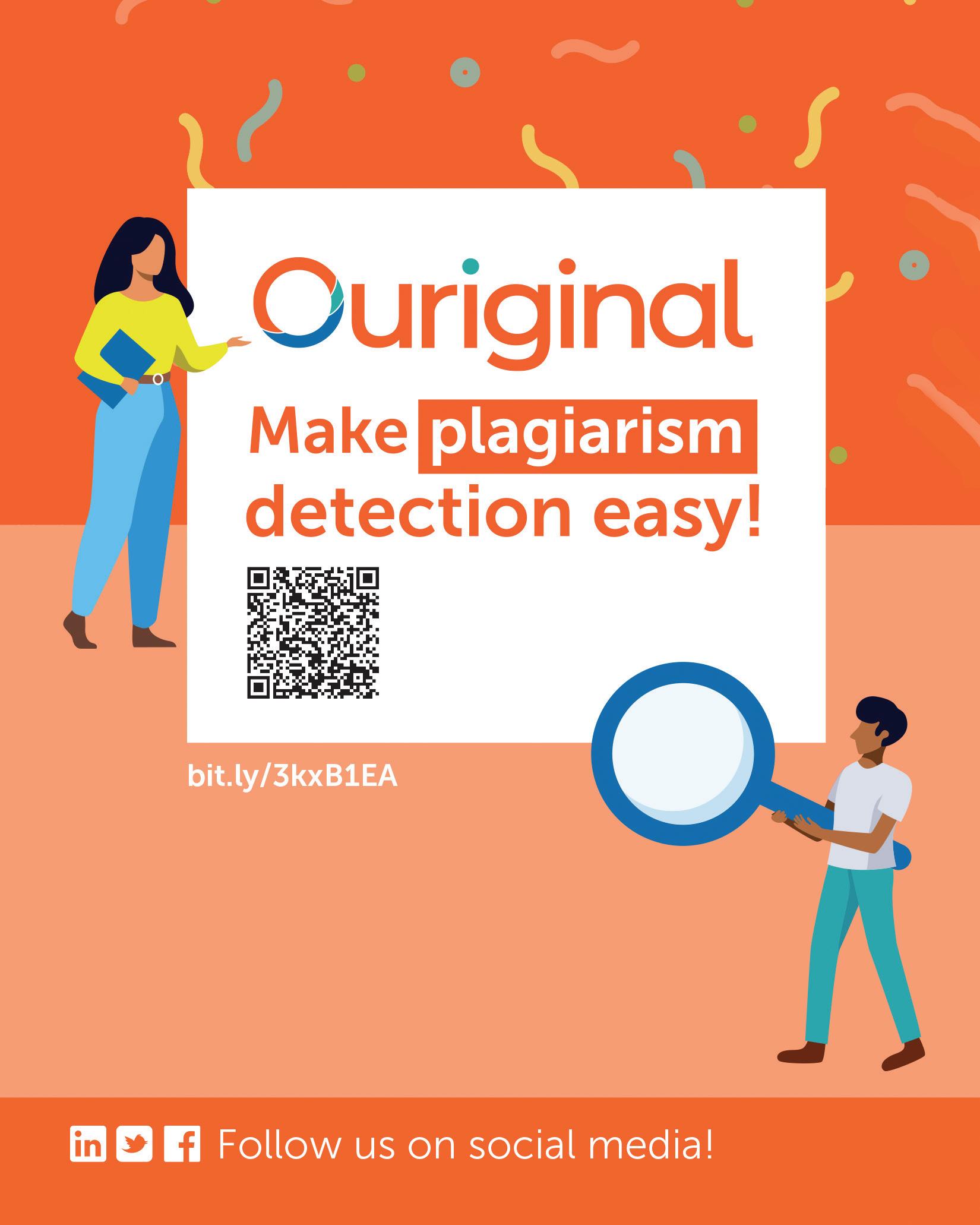


































December 2022 Vol - 4 Issue - 17
Head of Advisory Board
Dr. Manoj Varghese, Ph.D
Managing Editor Sarath Shyam
Consultant Editors
Dr. John Andrews
Anuja Mulmule
Emma James Andrew Scott Amrin Ahmed
Editorial Enquiry: admin@highereducationdigest.com
Creative Consultants
Charlie Jameson Manjunath R Louis Bernard
Naomi Wilson Stanly Lui Roshni Rajagopal Sabrina Samson Keith Alexander Ajay Das Rohith Poojary Shirley David
Branding & Marketing Partnerships
Jennifer Anderson Monica Davis Suchita Sethy Aakash Sawkar Jessica Edword
Rachel Roy Shubham Amle Anna Elza Stephen Donnell Cathy Che
Partnerships Enquiry: admin@highereducationdigest.com
Free Subscription www.highereducationdigest.com




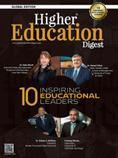
Americas 16192 Coastal Highway, Lewes, DE 19958, USA
Europe 27, Old Gloucester Street, London, WC1N 3AX, UK
Middle East & Africa P.O. Box 48299, Dubai Silicon Oasis, Dubai, UAE
Asia-Pacific Ramanashree Arcade, 18 MG Road, Bangalore – 560001, India
Higher Education Digest is a digital magazine published by Connecta Innovation Private Limited. All rights reserved. The opinions expressed in the content and pictures provided are those of the authors. They do not purport to reflect the opinions or views of the Connecta Innovation Private Limited or any of its members and we do not assume any responsibility. The publisher does not assume any responsibility for the advertisements, its content, pictures, and all representation of warranties made in such advertisements are those of the advertisers and not of the publisher.
Higher Education Digest is a Free Subscription digital magazine strictly not for sale and has to be strictly for internal private use only. Publisher does not assume any responsibility arising out of anyone printing copy of this digital magazine in any format and in any country and all matters related to that.
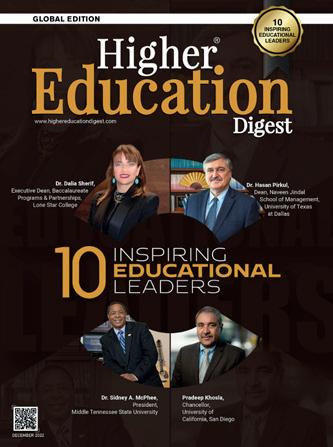
Alvin Toffler, an American writer, futurist, and businessman known for his works discussing modern technologies, once said, “The illiterate of the 21st century will not be those who cannot read and write, but those who cannot learn, unlearn and relearn.” That is indeed very true, especially in the context of the last couple of years. In the recent history of higher education, we never had a more difficult time than these two years. The pandemic forced us to think beyond the conventions and act diligently. It was a test of higher education leaders. Those who were ready to learn, unlearn and relearn graduated with flying colors.
When teachers and students had to apply adaptive strategies to the restrictions, it was even more challenging for academic leaders. They had to successfully engage all stakeholders - teachers, parents, students, and administrators- in decisionmaking and learning outcomes. Today, as the dust
settles, top-level academicians have recognized the need to shift to a future-oriented focus on transformational change to sustain and advance their core missions. To make this a reality, educational institutions require senior leaders with an innovative mindset open to disruptions.
In his issue, we celebrate the success of academic leaders worldwide by presenting The 10 Inspiring Educational Leaders - 2022, who understand the values of relationship, connectivity, collective wisdom, collaboration, empathy, and adaptive risk-taking. They have not just created a conducive learning environment for their institutions but contributed to making this world a better place to live. We hope our efforts to bring their stories to the limelight will inspire a whole new generation aspiring to make a mark in the education arena.
Enjoy Reading.
Sarath Shyam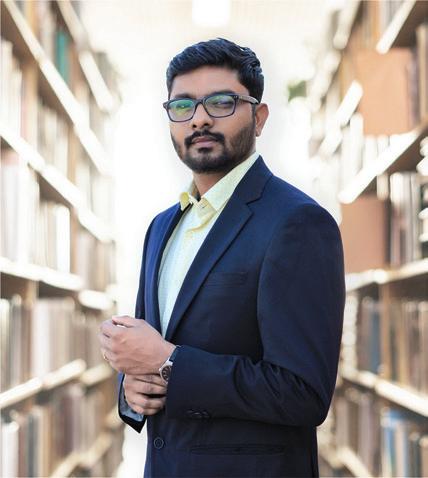
Mr. Amulya Sah, PGD PM & IR, PG Diploma in PM&IR (XISS Ranchi)
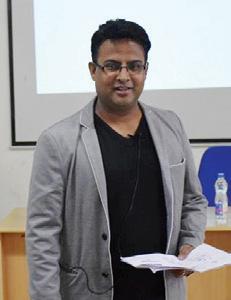
Chief Human Resources Officer, Former Head HR group Samsung R&D Institute India,Transformative HR Leader, Change agent, Digitization facilitator, Engagement architect, Trainer and Diversity champion.
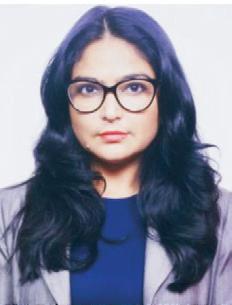
Dr. Varughese K.John, PhD, MBA, MPhil, MCom, LLB.

Former Program Director, MS in Management Program, GSATM - AU
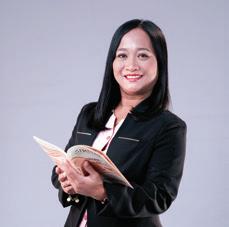
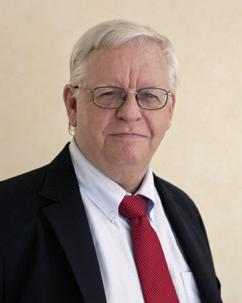
Dr. Ajay Shukla, Ph.D, MBA, BE. Co-founder and Chief Strategy Officer at Higher Education UAE
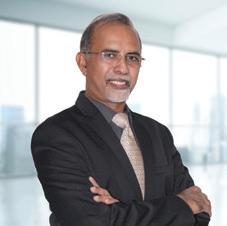
Major
Ex-M D Army Welfare Education Society, ExCOO GEMS Education - India, Ex- Addl Dir Gen - Army Education, Mentor - Adventure-Pulse
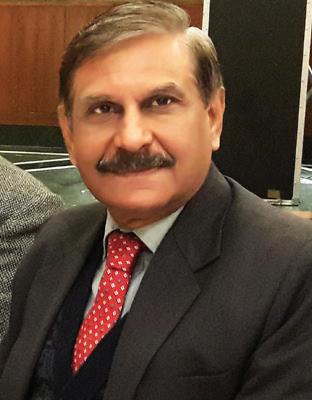
Dr. Kuldeep Nagi, Ph.D, MBA, BSc.

Former Program Director of Ph.D, Recipient of Fulbright Fellowship Award & Dan Evans Award for Excellence and Writer columnist.
Shanthi Rajan (MSHRM, FHEA, AMCILT) Director, Institution Development, University of Stirling, RAK Campus, UAE.
Dr. Hans A. Andrews Ed.D. Distinguished Fellow in Community College Leadership, Olney Central College, Illinois,USA
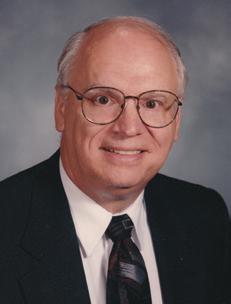
Mr. Sreedhar Bevara, MBA, B.Com

CEO at BMR Innovations, Ex Senior General Manager at Panasonic, LG, The Hindu, TATA, Author: Moment of Signal & The Roaring Lambs, Motivational Speaker & Leadership Consultant.
Dr. Khyati Shetty Ph.D (Marketing)., SFHEA (UK), MBA (Marketing), PGHRM, BA (Marketing & Economics)
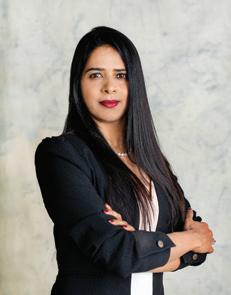
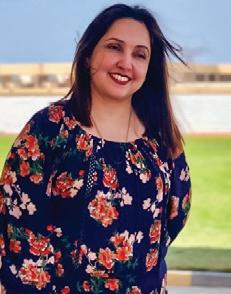
Dr. Manoj Varghese, Ph.D
Senior Director - Global Partnerships, Advisory & Consulting - Connecta® , Head of Advisory BoardHigher Education Digest® & K12 Digest® , Adjunct Faculty - Assumption University, Former CIO - Athena Education, Former Global Director TechnologyGEMS Education
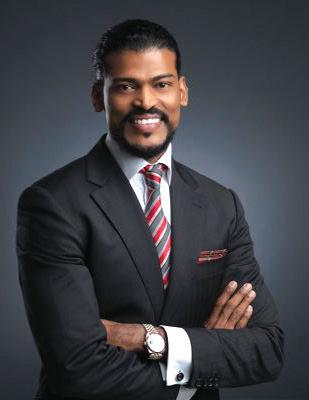
Creating a Superior Learning Environment for Future Entrepreneurs, Leaders, & Innovators
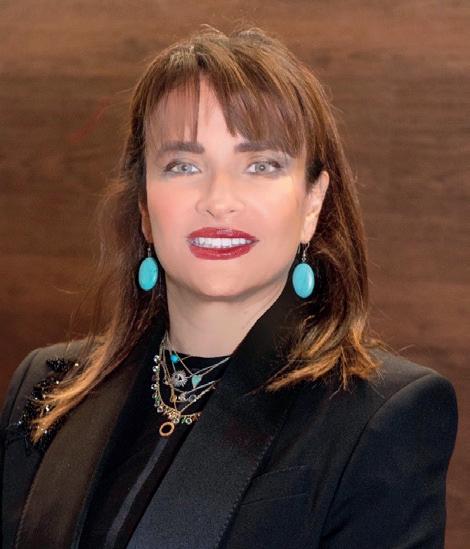
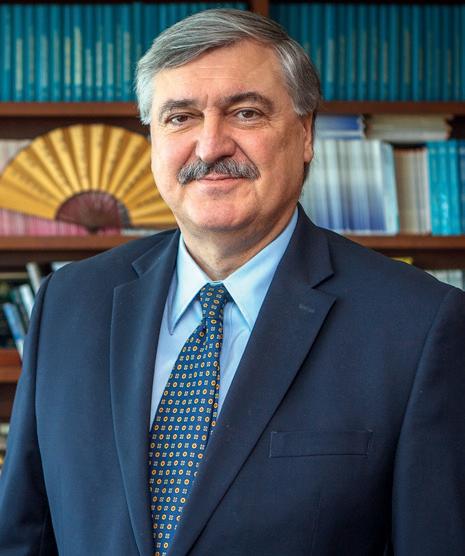
A Global Thought Leader, Redefining the Future of the Public Research University
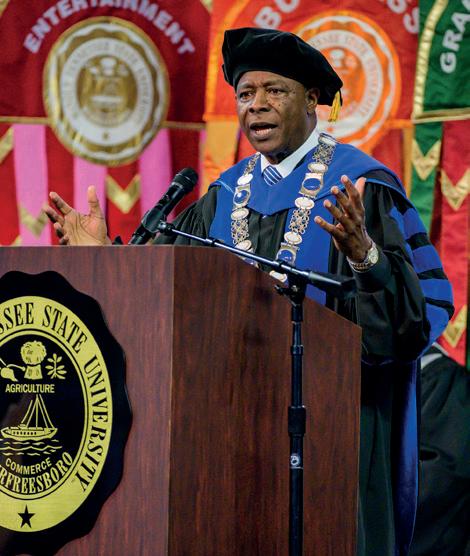

TEACHING AND RESEARCH: AN INTERTWINED RELATIONSHIP
Didi Griffioen, Professor and Head of the Department of Higher Education, Research & Innovation (HERI) at the Amsterdam

WHO SHOULD TEACH STUDENTS THE LEARNING SKILLS THEY TRULY NEED? THE UNIVERSITY, THE SCHOOL OR BOTH?
Leo Thompson, Independent Education Consultant and School Accreditation Specialist
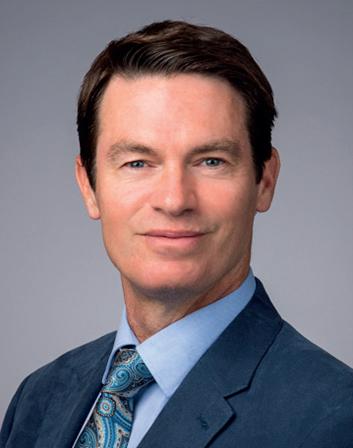
Dr. Nikola Perović, International Management Consultant and Coach

60
HOW ARTIFICIAL INTELLIGENCE IS EMPOWERING STUDENTS AND TEACHERS
Tatiana Torres, Virtual Teacher, Entrepreneur, and Content Creator
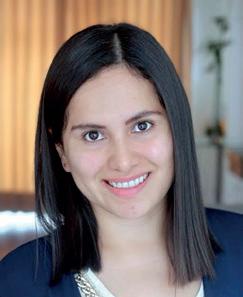
SCHOLARS, PRACTITIONERS, AND POLICYMAKERS CONVENE IN DC FOR ‘MOVING THE NEEDLE ON COLLEGE COMPLETION’
Terrell L. Strayhorn, Ph.D., Professor of Higher Education; Women’s, Gender & Sexuality Studies at Illinois State University

A.J. Merlino, Associate VP of Student Professional Development & Experiential Learning, Harrisburg University of Science and Technology

Didi Griffioen, Professor and Head of the Department of Higher Education, Research & Innovation (HERI) at the Amsterdam
Do you think teaching and research outputs are completely independent, neither enhancing nor detracting from each other? What is your take on the relationship between research and teaching?
Generally, perspectives of connecting research and education are rather normative. Many
consider it important or a good thing that they should be connected. My starting point is more pragmatic in nature: if we as a university or as a society decide – as we apparently have done – that both education and research should be placed within a single organizational entity – the university – then there should be some benefit to be had from that. Education and
Not all will call it ‘research’, not all will use methods of research or design, but all should know when to ask about what is true in a particular situation and what is needed for a proper answer, or whom to turn to for such an answer
Didi Griffioen, PhD. is a Professor and Head of the Department of Higher Education, Research & Innovation (HERI)attheAmsterdamUAS.SheishonoredbyaComeniusLeadershipFellowoftheDutchMinisterofEducation, which is similar to the UK NTF scheme. The here proposed book is the direct result of that fellowship. She was the first in the Netherlands to be admitted as a Principal Fellow (PFHEA) of Advance HE. She is a former chair of the Higher Education SIG of the Netherlands Education Research Association, and a former elected trustee and member of the Governing Council of the British Society for Research into Higher Education. She was chosen amongthe10personsmostinfluentialforEuropeanhighereducationin2018.HermostrecentbookisTheDesire for Change in Higher Education (Bloomsbury, 2022). She previously published ‘Integratie van Onderzoek in het Curriculum’ (Noordhoff, 2013). She has authored many (inter)national journal articles about the development of students,theconnectionsbetweenresearchandteaching,andorganisationaldevelopmentinhighereducation. She is a frequent speaker at national and international conferences.
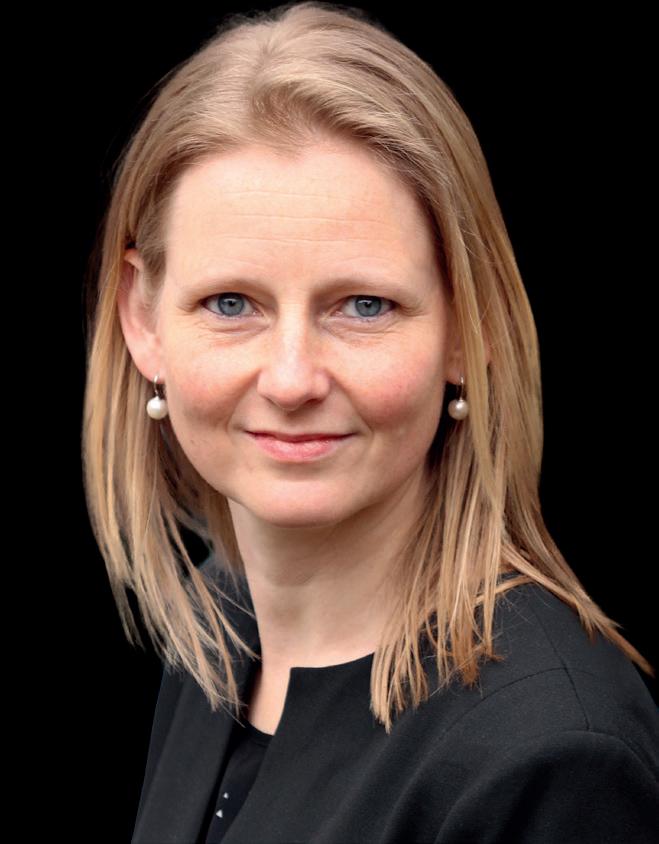
research are both knowledge-related activities, but they generally also are rather different in nature and practice. This makes it often difficult to have them connected or integrated. So, if we take it upon ourselves to have them both in the same organizational structure, we should also be willing to actively strive for the potential benefits of having them both in. If we are not willing to do so, there is no point in having put in the time, effort, and energy to have both in. Additionally, I believe that education is generally different when educated by research-active persons, but that is another perspective.
The book is based on a five-year strategic change project within my own applied university. Our assignment was to assist the 70+ undergraduate programs to have research further integrated into their curricula. The most energy in that project was needed to widen individuals’ perspectives on what is research, what is education, and how they relate to professional practice. Having multiple conversations about beliefs, experiences,

While writing the book Creating the Desire for Change in Higher Education, what perspectives or beliefs have you challenged?
practices, and what is the way to go for particular professional programs helped us to open up standpoints of ‘yes’ or ‘no’ to research to have more nuanced positions.
What is the importance of research according to you in the life of a student?
That depends. I believe it is important for each higher education student to learn how to relate notions to truth, to understand what one beliefs to be true in a particular context, and to ask one’s self why that belief is proper for that setting. That understanding is part of being a highly educated citizen in society. However, that does not always come in the same terminology or way of working. For a philosophy student, this is a foundational question, answered through logical reasoning and the use of written work. For an Applied Sports Business student, it can be a question of how to know what money to spend on a new product, including using market research tools. For some other students, it’s about using existing knowledge as part of an action-
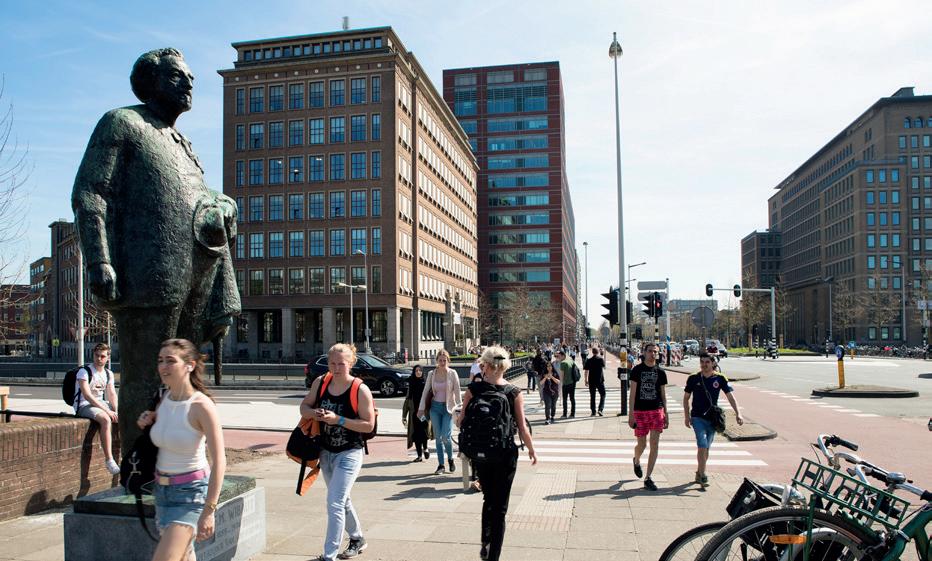
A lot of what knowledge is out there was used in the process of the strategic change program, but its usefulness only becomes more visible if the story and results are again structured beyond the daily messiness of a change process
reflection cycle in professional practice.
Not all will call it ‘research’, not all will use methods of research or design, but all should know when to ask about what is true in a particular situation and what is needed for a proper answer, or whom to turn to for such an answer.
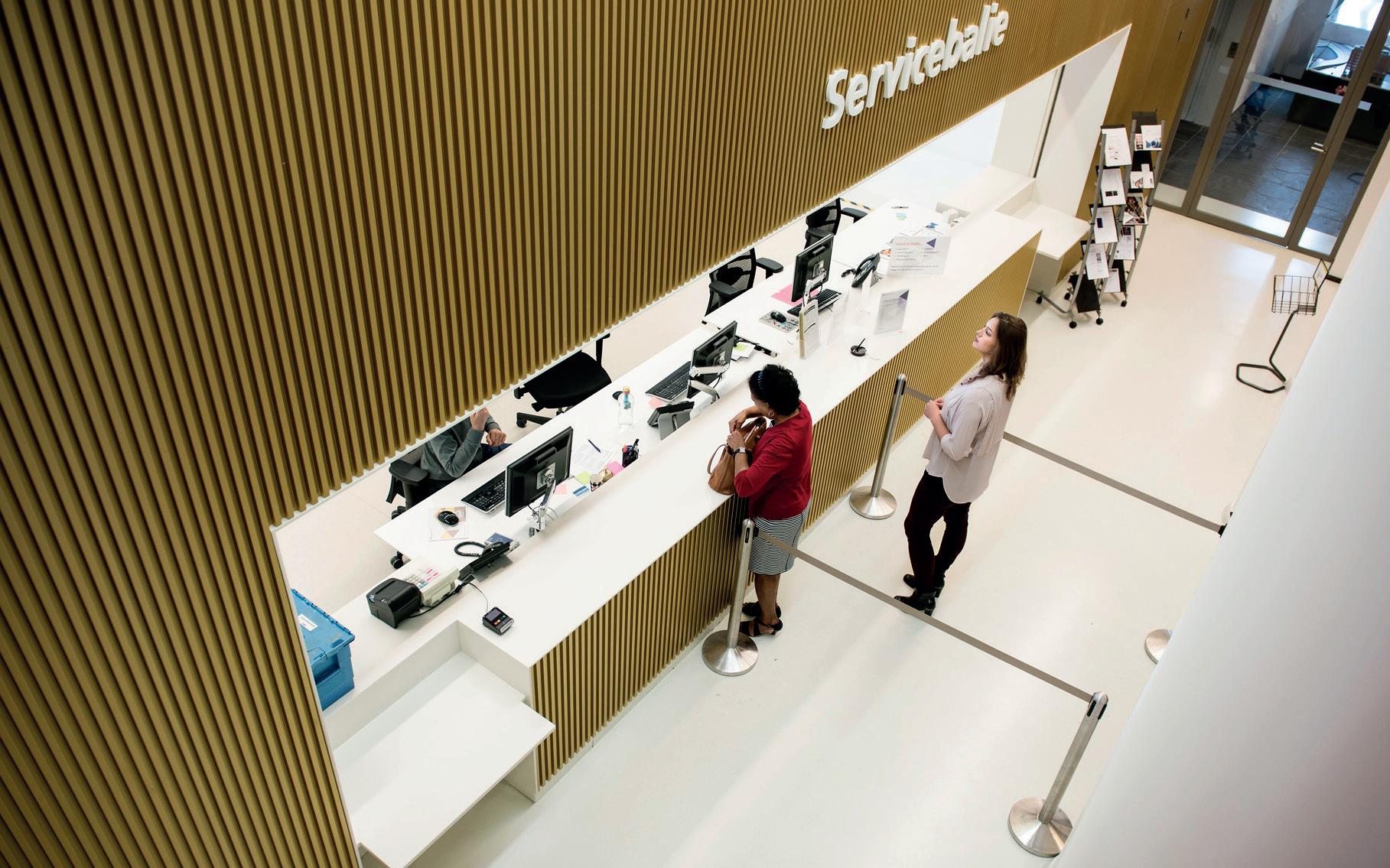
Your book, Creating the Desire for Change in Higher Education, brings together and builds upon the international bodies of knowledge on higher education change and on the relationship between research and teaching. What inspired you to pick up this topic?
Originally, I got interested in notions of research in the applied field a long time ago when I attended a presentation by colleagues
from Social Work at my university. They presented a work process of a project of students and colleagues in a community home in Amsterdam. It was an interesting project with multiple years of students involved and the citizens were rather happy about it. I could understand all that. What I did not understand was why they would call all that ‘research’, since I had a rather different understanding of that notion. That session started my search which ended with my Ph.D. thesis in 2013 with the title: Research in Higher Professional Education; A Staff perspective (University of Amsterdam), and my pan-university professorship Higher Education, Research & Innovation (HERI) in 2018 at Amsterdam University of Applied Sciences. The book is a sensible follow-up to all that.
What was your work schedule like when you were writing and working at the same time?
Writing as a way of disseminating is part of my work, so it was mainly important to arrange for the time in my schedule to get to it. Half of the chapters were co-authored with colleagues and students of my HERI team, which was nice but also asked for some tight logistics.
What part of the book gave you the most difficult time while writing?
The corrections. I generally enjoy the writing process but do not enjoy correcting again and again the same text to get it cleaned up. Luckily some of my colleagues are very able and willing to take part of that on. But that caused me the most trouble.
What was one of the most surprising things you learned while creating your book, Creating the Desire for Change in Higher Education?
What I learned I that a lot of our practices easily resonate with current literature and
that practices like ours indeed can contribute to theory as well. A lot of what knowledge is out there was used in the process of the strategic change program, but its usefulness only becomes more visible if the story and results are again structured beyond the daily messiness of a change process.
What is the most valuable piece of advice you’ve received about writing and do you have any advice for the teaching community?
Make time and just do it. Write it up (or video or blog or... if writing is not your thing). It is so important that we collectively try to build on all our practical knowledge and experience about higher education. We all do so much, know so much, and share so little beyond our immediate colleagues. And the only way to improve our higher education practices is to systematically share all our practical knowledge and experiences beyond our own department or university. Hopefully, this book can be a stimulus for others to do
same.
the
It is important for each higher education student to learn how to relate notions to truth, to understand what one beliefs to be true in a particular context, and to ask one’s self why that belief is proper for that setting
Website: https://www.ehl.edu/

Location: Lausanne, Switzerland
About the Institution: EHL combines the Swiss values of academic rigor and industry practice with creativity and innovation for modern hospitality management degrees that prepare graduates to lead the future of the industry and the world.
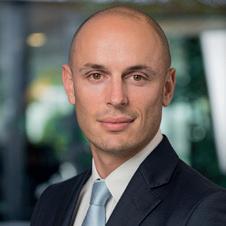
Website: https://www.lonestar.edu/
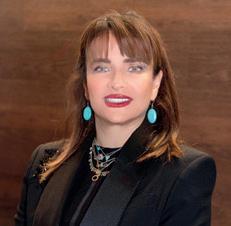
Location: Texas, USA
About the Institution: Lone Star College enrolls over 80,000 students each semester providing high-quality, low-cost academic transfer and career training education.

Interim Dean, Faculty of Arts, Cultures and Education, University of Hull
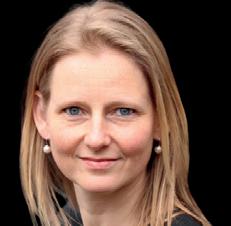

Website: https://www.hull.ac.uk/
Location: Hull, United Kingdom
About the Institution: Founded as a college of the University of London in 1927 and granted independence by royal charter in 1954, the University of Hull is an established international education provider with a student population of almost 21,000.
Professor and Head of the Department of Higher Education, Amsterdam University of Applied Sciences
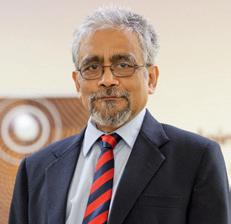
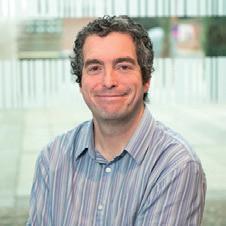
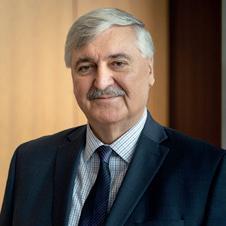
Website: https://www.hva.nl/

Location: Amsterdam, Netherlands
About the Institution: The Amsterdam University of Applied Sciences/Hogeschool van Amsterdam (AUAS/HvA) is a knowledge institution that educates tomorrow’s professionals in a wide array of fields and disciplines of higher education.
Website: https://www.spjain.org/
Location: Bengaluru, India
About the Institution: With campuses in the dynamic business hubs of Dubai, Mumbai, Singapore and Sydney, SP Jain is renowned for offering multi-city undergraduate and postgraduate programs.

Website: https://jindal.utdallas.edu/

Location: Texas, USA
About the Institution: The Naveen Jindal School of Management’s mission is to meet the challenges of a rapidly changing, technologydriven, global society by conducting relevant research and providing high quality education to the future business leaders of the world.
Website: https://www.wlu.ca/
Location: Waterloo, Canada
About the Institution: Established in 1911, Wilfrid Laurier University is a leading Canadian university known for academic excellence and a culture that inspires lives of leadership and purpose.


Website: https://ucsd.edu/
Location: California, USA
About the Institution: UC San Diego is transforming California and a diverse global society by educating, by generating and disseminating knowledge and creative works, and by engaging in public service.
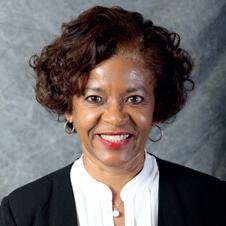
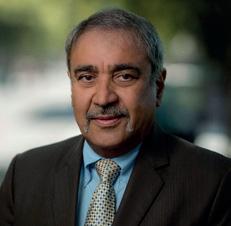
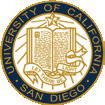
Website: https://www.mtsu.edu/
Location: Tennessee, USA
About the Institution: Middle Tennessee State University is composed of eight undergraduate colleges, offering more than 40 departments and more than 180 degree programs. The College of Graduate Studies offers more than 100 degree programs.
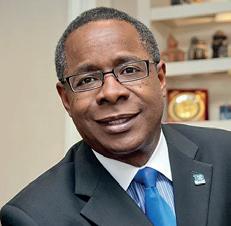

Website: https://www.richmond.edu/
Location: Virginia, USA
About the Institution: The University of Richmond is committed to educating in an intellectually vibrant community dedicated to the holistic development of students.


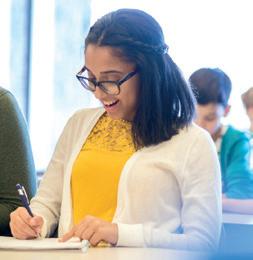

Executive Dean, Baccalaureate Programs & Partnerships, Lone Star College
From the aftermath of a war to a revolution and finally a global pandemic, Dr. Dalia Sherif (Executive Dean, Baccalaureate Programs & Partnerships at Lone Star College) has witnessed unimaginable things come true at various stages of her life and career. However, she has always had a strong will, as fierce as fire; no storm so harsh could make her lose her sparkle. An honoree of ‘Woman Who Means Business,’ Dalia’s professional journey is nothing short of inspiring.
Born and raised in Egypt, Dr. Sherif was encouraged by her father since childhood to dare to dream. “As the seeds of my grand dreams began blossoming, I realized that education was the most
I found sharing my international business experience with the younger generation of students extremely rewarding, and I fell in love with teaching and passing forward knowledge

powerful tool I could use to reap those dreams,” reveals Dr. Sherif.
From then on, education became a key driver of Dalia’s life. She became both a professional dreamer and a life-long learner. “I realized that dreaming is just a simple application of stretched goals; aiming higher than you think you could reach, setting extremely ambitious goals, and pushing yourself to new heights,” explains Dr. Sherif. With a bit of luck on her side and a lifelong learning attitude, Dr. Sherif found herself ready to take on the world.
Beginning her career with U.S. Agency for International Development in Cairo, Egypt, Dr. Sherif enjoyed the flattering environment of diplomacy and international relations. She quickly joined the U.S. Department of Commerce located at the U.S. Embassy in
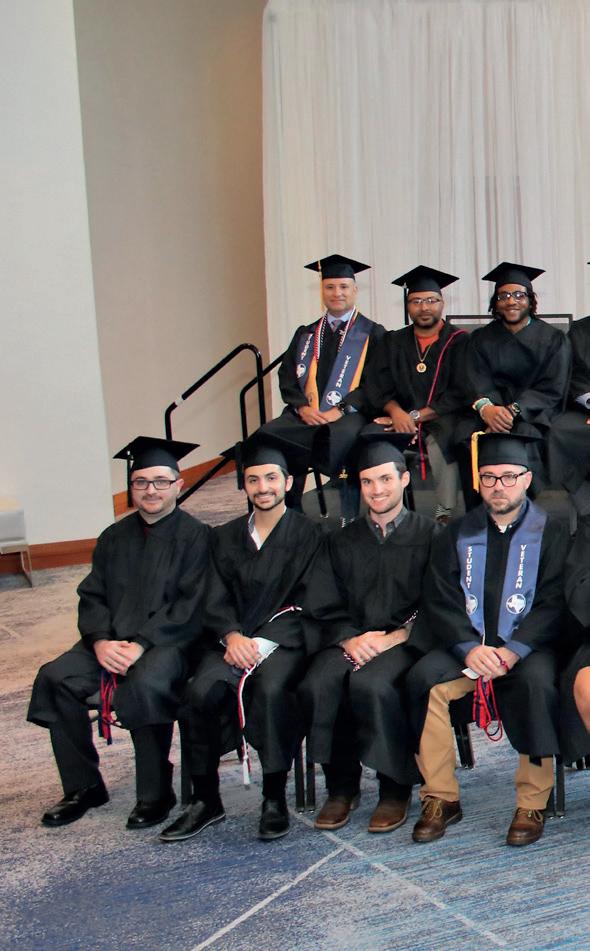

LSC is an awardwinning higher education institution, providing comprehensive educational opportunities and programs to enrich livesHouston Business Journal Women Who Mean Business Award
Cairo and received ten meritorious honors and extra mile awards for forging export successes exceeding USD 300 million during her stint. As she reached the pinnacle of her career, the Egyptian revolution broke out and left her without any foreseeable options. However, as one door slammed shut, another door creaked open. That same year, Dr. Sherif won the diversity visa lottery and moved to the USA with her family.
Being in a new and unfamiliar environment, Dr. Sherif viewed her situation as a minor setback for a major comeback. This was also the
time when she saw how education continued to play a life-saving role during her tough times. With an MBA degree, international business knowledge, marketing skills, and multilingual proficiency, Dr. Sherif became a unique, soughtafter professional candidate. “I found sharing my international business experience with the younger generation of students extremely rewarding, and I fell in love with teaching and passing forward knowledge,” fondly shares Dr. Sherif.
Later on, Dalia pursued her Ph.D. degree from Grand Canyon University in industrial and
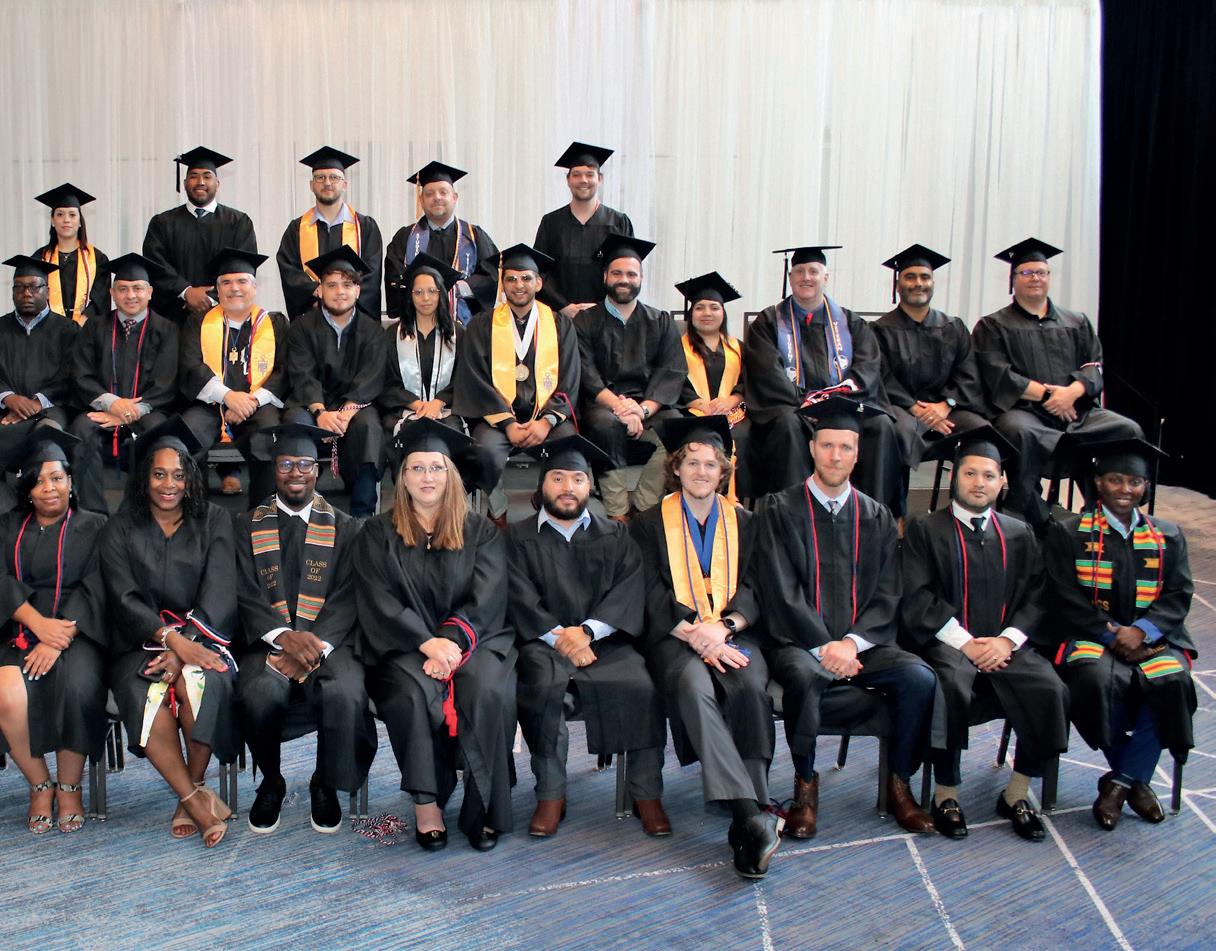
organizational psychology. She was juggling a full-time degree and a family of five at that time. Her five-year-long Ph.D. journey was challenging yet rewarding as it allowed her to transition from one position to the next. By growing the MBA program at the University of Houston downtown from the smallest in Houston to the largest in Texas, Dalia was recognized by the Houston Business Journal as a Woman Who Means Business. “This recognition and completion of my terminal degree emphasized to me that everything happens for a reason,” mentions Dr. Sherif. Like before, another fantastic opportunity came her way in the form of Lone Star College (LSC), one of the best employers in the USA. She joined LSC as a full-time faculty to build
their new bachelor’s program in management. Soon enough, stepped into the Executive Dean’s position to grow all four bachelor’s programs during the global pandemic times and tripled their enrollment in just one year.

As the Executive Dean of Baccalaureate Programs & Partnerships at LSC, Dalia’s first day started during the stay-at-home order. It meant meeting her team through the camera. “This was ironic in a way because you are trying to build community and bring people closer, all while emphasizing the importance of maintaining a safe distance,” asserts Dr. Sherif.
However, this became an excellent opportunity for Dalia and her team to get
acquainted with each other. They used various motivational and inspirational tactics for team building, including a weekly encouraging photo contest, staff recognition, participation in the Clifton Strength team building test, and online coffee chats. “During the first days on the job, I focused on preparing myself to accelerate once the situation would allow us and matched the strategy to the situation and negotiated what success meant to each of my team members to achieve goal alignment,” eagerly shares Dalia. Finally, to keep track of their progress and maintain momentum, Dr. Sherif and her team celebrated all their small victories together.
Texas-based LSC is an award-winning higher education institution, providing comprehensive educational opportunities and programs to enrich lives. LSC’s mission is centered around assisting students in achieving academic success through persistence and retention, promoting understanding of course concepts, reinforcing essential study skills and habits, and encouraging independent learning to help them reach their educational goals.
LSC is a second home to 2,880 international students, having one of the USA’s most extensive global student populations. This is due to the fact that the institution’s ‘ONE LSC’ culture and mindset exemplify embracing the diversity that its students, faculty, and staff bring to the campus. As a result, LSC has become a great place to get first-hand exposure to diversity in the real world: within one of the most diverse campuses in the USA.
Dr. Sherif reveals that the secret to motivating faculty members is to make them feel valued. This means being available, becoming sensitive to their workloads, and constantly checking in with them if they need help. Likewise, small but timely gestures of gratitude can make them feel appreciated and acknowledged.
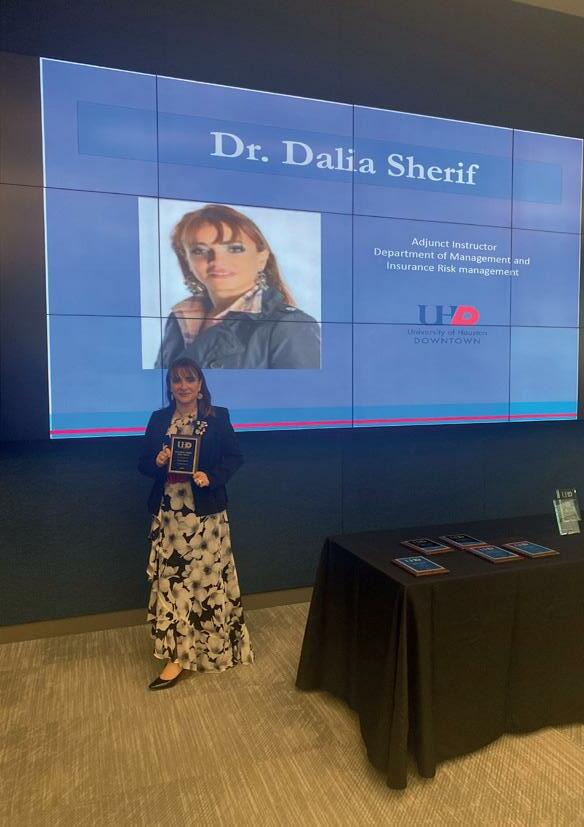
Moreover, the professional development of faculty members is also a key area that should be stressed. As leaders, one must ensure to give their faculty a clear direction and a voice, empower and recognize their individual strengths, encourage peer collaboration, and support the execution of their proposed strategies. Through these efforts, their motivation will never fade away. Finally, it is crucial to recognize their overload times and avoid introducing new projects during critical periods, such as papergrading periods or before final exams.
Throughout her journey, Dr. Sherif has encountered numerous hurdles, whether aiming for a graduate degree or juggling multiple
The best team ever!
responsibilities of living in Egypt, working in the USA, or being a mum to her young children. However, she never compromised over her dreams, dismissed them, or settled for less. She always has and continues to emerge as gold. Ultimately, it takes a strong, courageous, and brave woman like Dalia to conquer dreams irrespective of adversities.
Looking back, Dalia smiles and shares, “Believe in your real value, trust yourself, and know that only you can make the decision for what you believe your worth is.”
For Dalia, immigrating to the USA and embracing all the nuances and the acculturation process was a huge milestone for her. Likewise, studying and
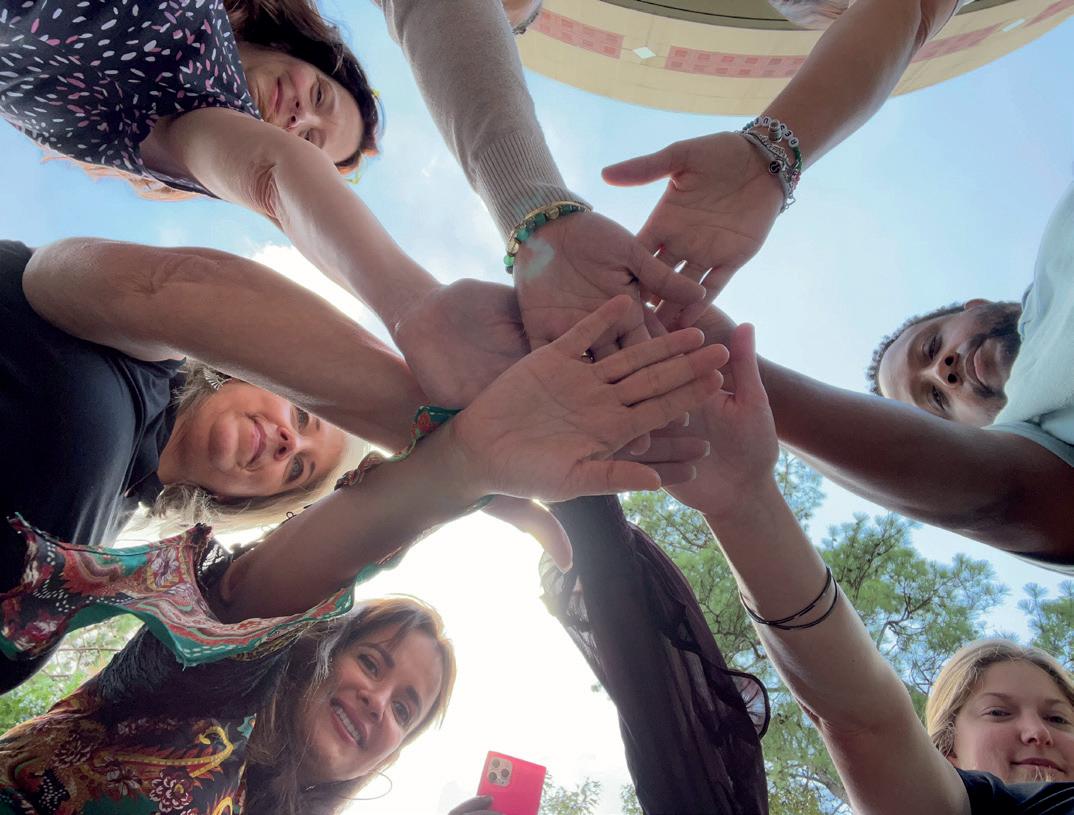
graduating from three great universities on three different continents was not only a milestone but a huge part of her international brand and iconic diversity assimilation.
Dalia’s next significant milestone is earning her Ph.D. degree, which was the most difficult, yet fulfilling experience. She says, “I wish I could freeze time back to the moment when I walked across the stage, realized that this was my terminal degree, and processed the fact that I will be a doctor for life.” Finally, joining LSC is another significant milestone for Dr. Sherif. “The leadership team, my colleagues, my team members, and the world’s best faculty are all incredible people like no other professionals I have seen before,” states Dalia.
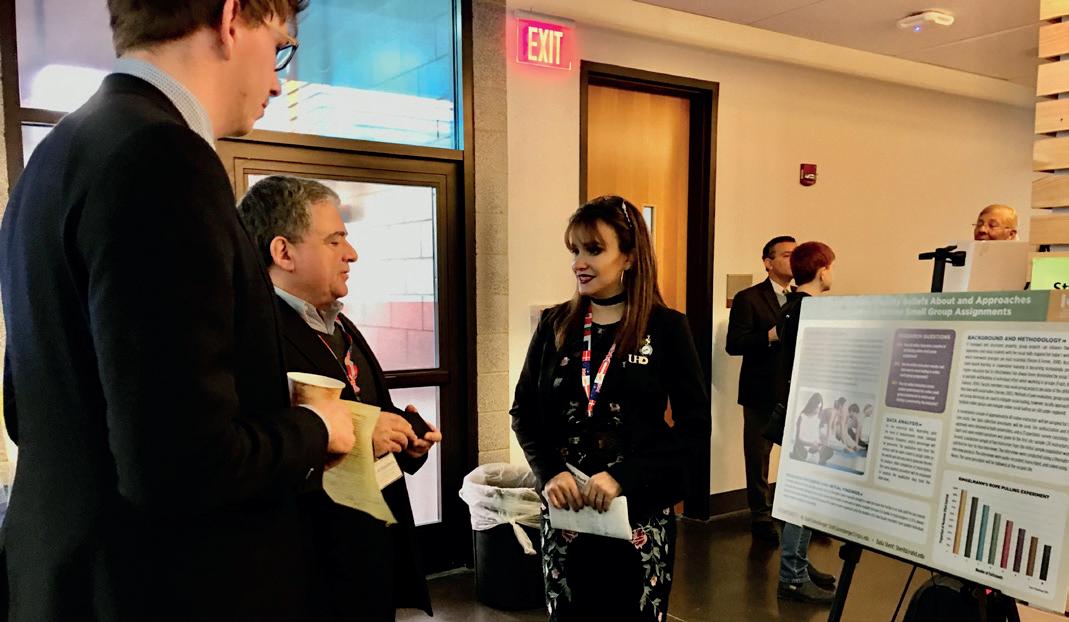
Under Dalia’s leadership, LSC recently launched its fourth bachelor’s degree program, Bachelor of Applied Science in Emergency ManagementPoster Presentation at 6th International Conference on Innovation and Entrepreneurship (ICIE 2018) held at University of District Columbia in Washington, D.C.
“I truly believe I have the best job in the world,” shares Dr. Sherif. She finds it rewarding to help students and positively impact their lives, one student at a time. She further implies that having navigated through the toughest of all times, she has learned to grow an unshakable core of calmness, slowly but surely.
Having read the book, Resilient by Being Well Podcast hosts Dr. Rick and Forrest Hanson, Dr. Dalia feels that one must possess grit and determination to withstand adversity, stay calm, and evaluate things rationally; one must choose to respond rather than react. “The two major well-being boosters, mindfulness, and meditation, have helped me preserve through the toughest and most stressful times,” reveals Dr. Dalia.
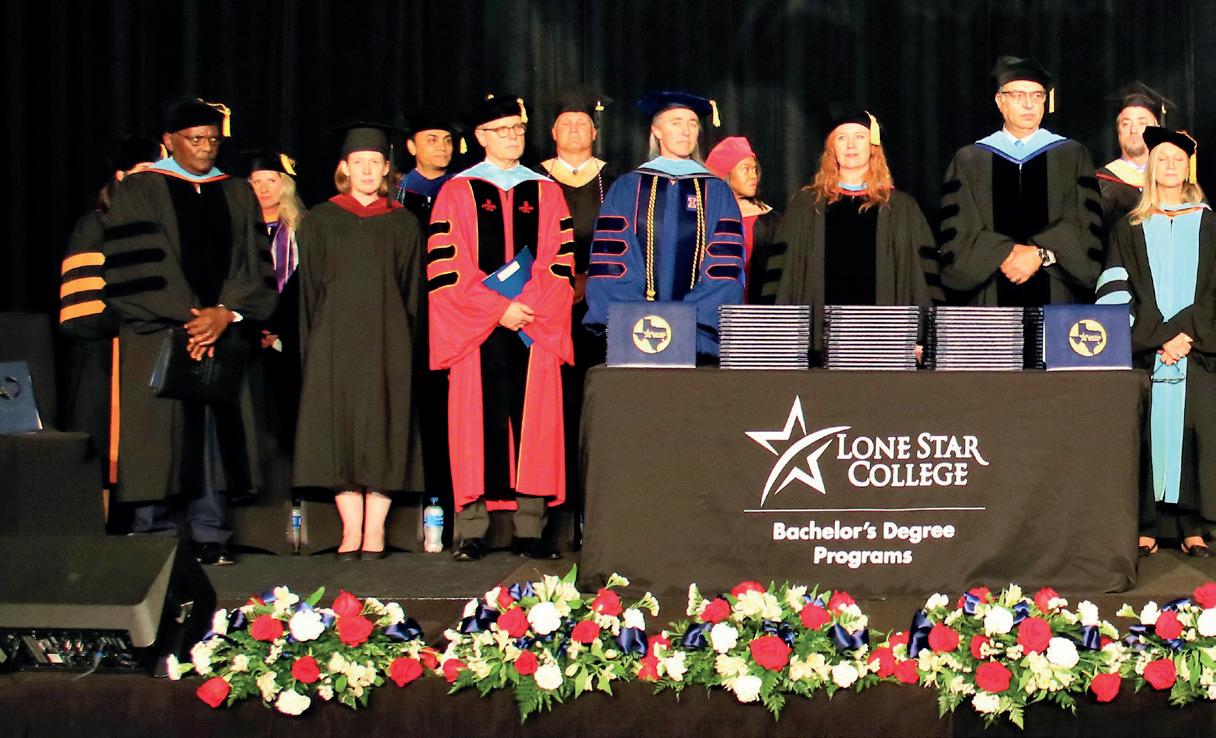
A dual degree holder, Dr. Sherif shares that every educator must possess a lifelong learning attitude. It doesn’t necessarily have to be earning a new degree or credential; it could be acquiring a new skill or simply reading a new book. Openness and receptiveness to new ideas and information help educators to have an extraordinary vision when they advocate or mentor other learners.
“It is an entertainment of teaching and learning, where we can learn from our students as much as they learn from us,” opines Dr. Sherif. To stay relevant with the times and provide practical learning to students, educators must also keep on upskilling and reskilling themselves.
Known for being a step ahead in its approach, LSC has pioneered the integration of Artificial Intelligence (AI) and Virtual Reality (VR) in classrooms, including Oculus VR, which will be used to simulate interviews and handle difficult negotiations and conversations in management and HR classes in its upcoming bachelor’s programs.
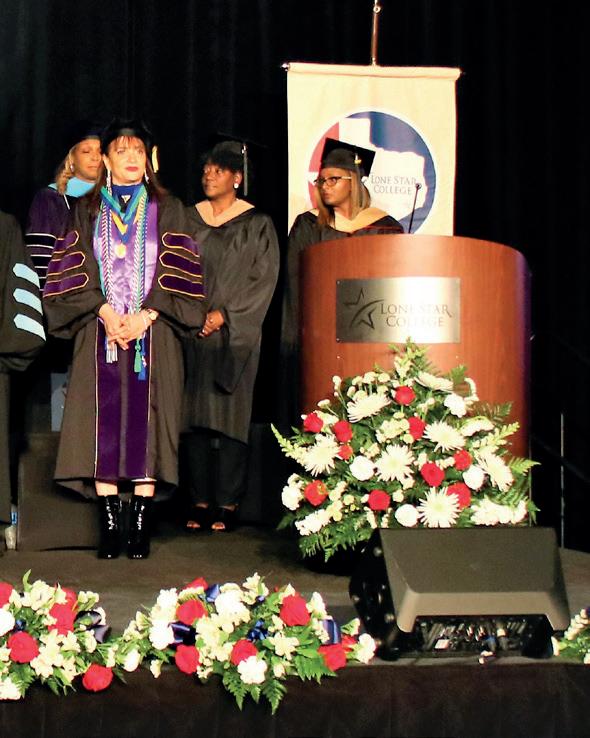
Dr. Sherif, therefore, recommends other colleges incorporate a replication of environments and simulated presence as a real learning experience that mirrors reality and brings lessons to life. VR can also help in teaching students how to network, bridge cultures, and even conduct virtual study abroad tours. In a nutshell, VR and AI are the gateways
to endless possibilities in revolutionizing the traditional classroom experience.
Under Dr. Sherif’s leadership, LSC recently launched its fourth bachelor’s degree program in Emergency Management. Apart from this, as an active member with Katy Rotary, and a board member of the Asian Chamber of Commerce (ACC), East End Chamber of Commerce (EECC), and Women Professionals in Government (WPG), Dr. Dalia and other members of the executive committee recently awarded tens of needbased and merit-based scholarships to students as a token of support to help them pay for their college degree.
The Road Ahead
LSC started offering a permanent online campus option not long ago and is enrolling students for the fall 2022 semester through its official website. Over 1, 900 students have already enrolled, with 1, 400 seats available for grabs. Moreover, online classes will still be available through the different LSC campuses, and students who take some classes online can also take courses in person or in a hybrid form.
Currently, LSC-Online is offering more than 30 online programs but plans to expand offerings as they become necessary and sustainable. Through LSC-Online, LSC aims to expand its students’ reach, including out-of-state and military students.
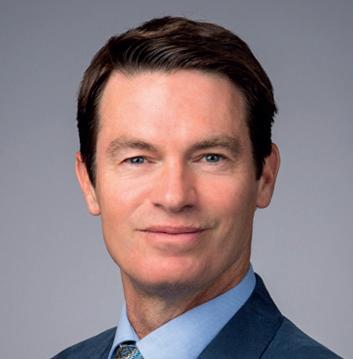
Leo Thompson MA, MEd is dedicated to empowering people to learn and grow through applied education research and innovation. Committed to global citizenship, Leo has a deep appreciation for different cultures and often visits schools internationally to appreciate their strengths and support their continuous journey towards excellence in their context. A former teacher and school head, he is now an independent education consultant, writer and speaker who lives in Vienna, Austria.
For Leo, being successful must mean bringing sustainable value and well-being to the worldinwhateveryoudo.
Schools don’t play the role they could in gearing up students for higher education. The curriculum pattern in the school system is mostly confined to bookish resources with an emphasis n exams. Therefore, students are not prepared for the original thinking demanded at university level.”— Lubhna Dongre, age 21, Indian university graduate and author.
We know that each year millions of students globally walk through the gates of a university
for the first time. This hallowed ground is the next chapter of their education and life. But are they fully prepared for it? And if not why?
We also know that ending formal education to enter tertiary education is a major step in life’s path towards work for these students. Yet, it is like a change in radio frequency. School’s run on FM, universities run on AM. Let me explain with simple images and a table below. Interviewed students, just like Lubhna who will feature more in this article, are saying the same about the gulf in expectations.
In addition to learning more complex content, university students are also often expected to learn how to think critically and independently, engage in deep analysis and research, and to communicate their ideas effectively
The radio frequency is an analogy I would choose as schools and universities typically work differently when it comes to three learning specific areas.
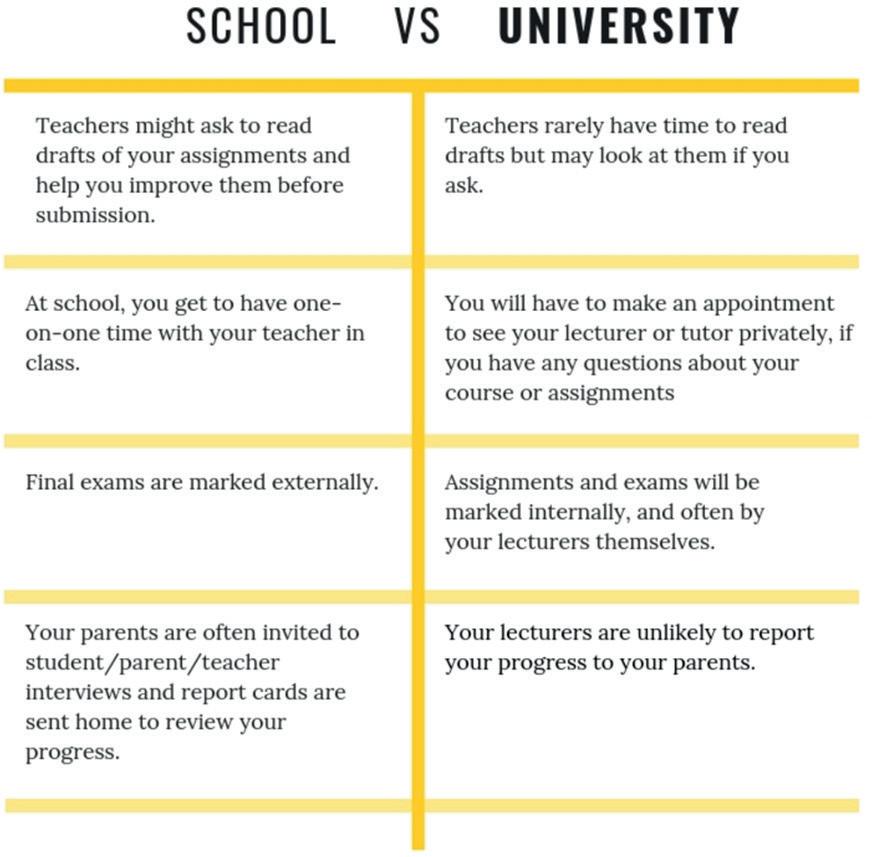
1) The level of learning independence required
2) The volume of information/content that must be learned and understood
3) The level of higher order thinking (see Bloom) required to be successful
To illustrate:

Though the dynamic is gradually changing, the traditional school model has been: The curriculum is set teachers instruct student learns (dependently) Though it is also evolving, the traditional university model has been: The learning outcomes are set lecturers facilitate students learn (independently)
Getting harder!
Yes, typically students are expected to read,
learn, and apply much more content at the university level than they did in high school. This is because university courses are intentionally more advanced and specialized than high school courses, and they often cover a wider range of topics with much more independent reading required. The volume of content is accelerating.
To this end, Dr Justin Sung, head of learning at iCanStudy depicts the scale and implications of the problem in a recent Monash University published article that “students often fail to finish the required amount of reading, especially when assignments and examinations are imminent; Zeivots found that up to 80% don’t complete their assigned readings.”
In addition to learning more complex content, university students are also often expected to learn how to think critically and independently, engage in deep analysis and research, and to communicate their ideas effectively. These skills can help students to be successful in their university studies and in their future careers. So, let’s revert back to the topic of who is responsible to teach students the skills they need and what services universities currently offer.
If anything, universities use a more flipped classroom model and schools typically use a more traditional model. In the flipped model, students are expected to be independent, motivated, high order, self-regulated thinkers and doers. The student must hit the books (read up) outside the baseline lectures and follow up discussion seminars that are used to introduce and consolidate the material and content.
The pursuant end of module, or end of year, exams can be on anything within the designated reading materials, which can be very broad and deep. Universities realise that students come from a variety of backgrounds and hence levels of preparedness and try to give them some essential skills as part of an academic support programme (sometimes known as an ASP). This is well intentioned but is it enough?
Academic support programs at universities typically offer a range of services and resources designed to help students succeed in their studies. These programs may include
Learning how to learn is an important skill that will help students throughout their entire lives, not just during schools and college
research skills, citation, tutoring, writing centres, study skills workshops, and other types of academic assistance. They may also offer support for students with learning differences or disabilities, such as providing accommodations or specialized services.
In addition to providing direct academic support, academic support programs may also offer resources and advice to help students manage their time, set goals, and stay on track with their studies. Overall, the goal of academic support programs is to help students to be successful in their university courses and to reach their academic potential. These are no doubt helpful to many but may be a BandAid (superficial) solution with so much content to cover and at such a high level. The main skill of learning to learn independently seems to be missing.
Very varying levels of learning to learn components in schools
It depends on the school and the specific curriculum that is being taught. Some schools may place a greater emphasis on teaching students how to learn and develop critical thinking skills, while others may focus more on teaching specific subjects and content. In general, however, many schools or education systems do not adequately prepare students for the demands of university-level learning.

Universities realise that students come from a variety of backgrounds and hence levels of preparedness and try to give them some essential skills as part of an academic support programme (sometimes known as an ASP). This is well intentioned but is it enough?
Consequently, students need to develop additional skills and strategies to be successful in their university studies. Having talked to many of my former students and alumni who have ventured to university, most comment on the explosion in content volume, difficulty and independence required.
Again, Lubhna Dongre commented, “the student is generally required to fight their way through school and university facing academic and peer challenges with social expectations towards future studies or employment.”
Learning how to learn is an important skill that will help students throughout their entire lives, not just during schools and college. Teaching students how to learn can help them to become more independent, self-aware, metacognitive, self-motivated, confident and efficient learners, will ultimately lead to better academic performance and a more successful college experience. Additionally, teaching students how to learn before they go to college can help to prepare them for the unique challenges and demands of higher education as well as help to set them up for success in their future careers. It builds a bridge between school, university, and life in general.
The Diffused Responsibility theory or phenomenon usually applies to situations where there are many people witnessing a disturbing incident where someone needs help and yet nobody acts. This theory can also be borrowed and applied to schools and universities. Is it the student’s responsibility
to take learning ownership when they do not know how? Is it the parents’ responsibility to instil skills in their child when they do not know how? Is it the school’s responsibility when they have partial knowledge of learn to learn? Or is it the university’s responsibility? To a degree, perhaps ownership should be shared by the most informed and universities and schools should give much greater attention to ‘learning to learn’. Imagine the possibilities if every child and every student had access to this life tool and their parents encouraged it?
Michael Tsai - Cofounder of iCanStudy who are aiming to revolutionise learning to learn by building a 100% research driven integrated system to empower humans - commented on the shortfall in education that schools and universities globally have not yet addressed despite positive intent:
“A metaphor for the current situation is that you have a fully equipped kitchen, but without a recipe and skills training you cannot use it to the full capacity. Learning to learn is the only really sustainable solution for students at all ages in the hyper information age.”
To wrap up, an alma mater can be translated from Latin to ‘Kind Mother’. Universities are indeed wonderful institutions.
However, to continue with the analogy the mother could be even more kind by focusing on learning to learn by way of teaching students an integrated system within the universities’ academic support programmes. This will help the mental health of the students, amongst other win/win benefits.
…and, as Lubhna suggests, schools and universities should both take responsibility for this. Then students will be both AM and FM ready.
Dean, Naveen Jindal School of Management, University of Texas at Dallas
Dr. Hasan Pirkul is an award-winning academic leader, researcher, Ph.D. advisor, and professor.
As the Dean and Caruth Chair, Dr. Pirkul has been leading the Naveen Jindal School of Management through tremendous growth to increasing stature since 1996. His dedication, vision, and pursuit of excellence helped the university to create an academic environment fostering scholarly inquiry, innovative teaching, and research productivity. Under his leadership, the school’s academic programs are continually ranked in The Princeton Review, Bloomberg Businessweek, and U.S. News & World Report. Dr. Pirkul is truly an inspiring educational leader, delivering superior educational guidance to the next generation of entrepreneurs, leaders, and innovators.
Our mission is to meet the challenges of a rapidly changing, technology-driven, global society by partnering with the business community to conduct research enhancing management knowledge; deliver high-quality management education to a diverse group of undergraduate and graduate students and practicing executives; and develop, innovate, and continuously improve programs advancing management education and practice
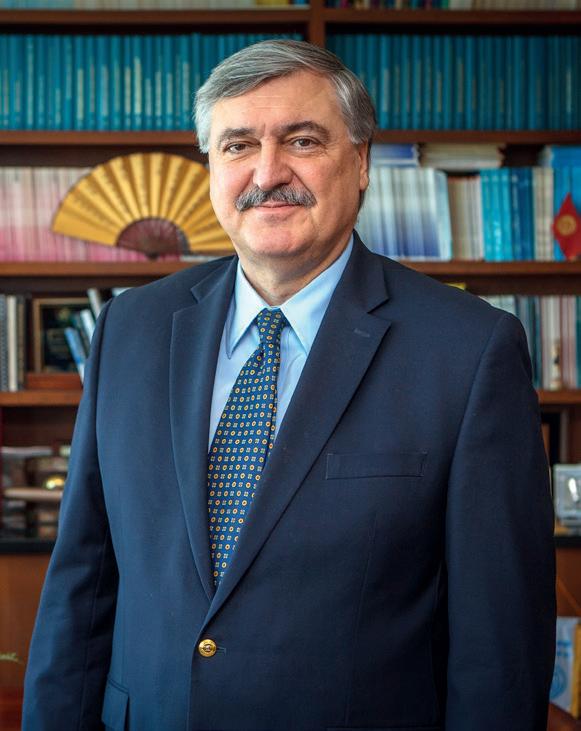
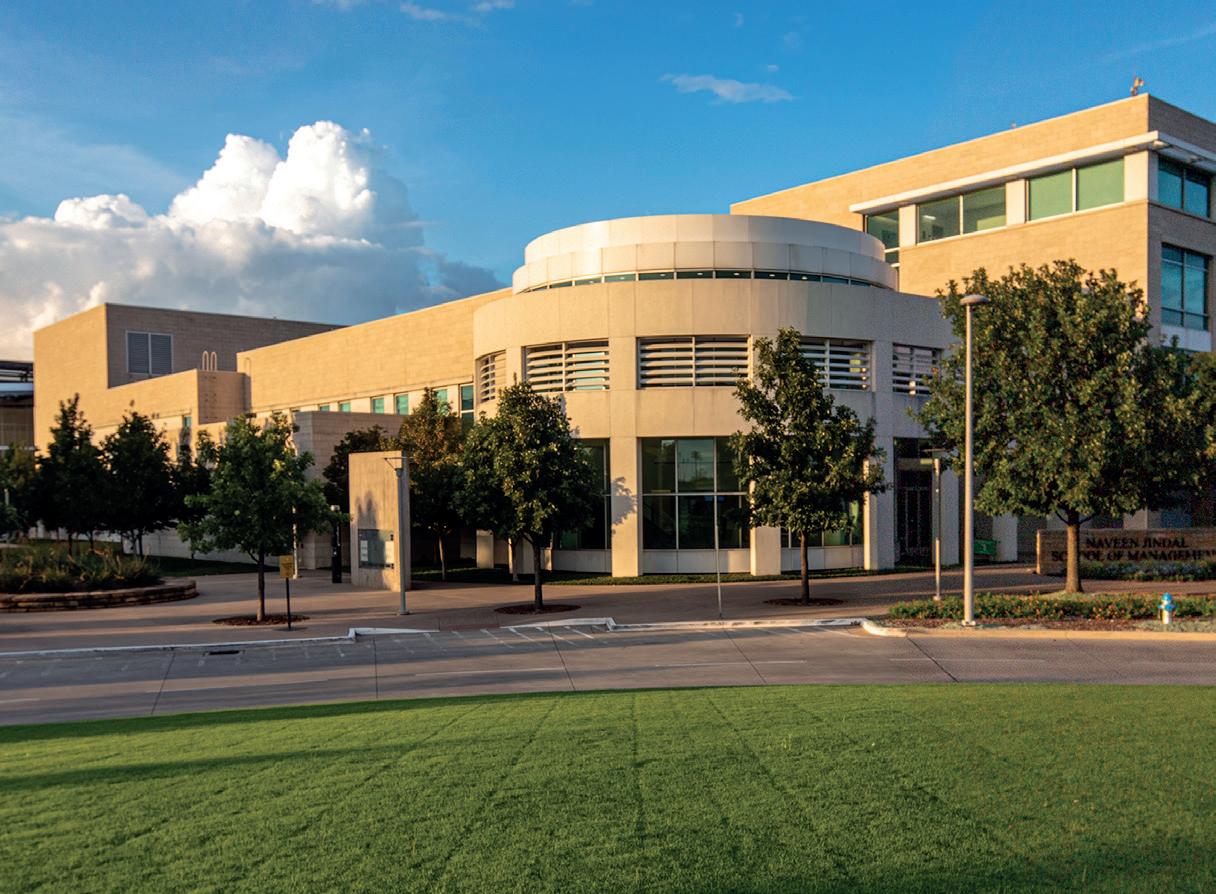
Since childhood, Dr. Pirkul looked up to his entrepreneur father, who played a significant role in shaping him into the leader he is today. Moreover, Dr. Pirkul’s family motivated his siblings and him from an early age to aim high and be confident in one’s abilities to achieve targeted goals. These teachings helped him in achieving greater goals throughout his life.
In college, after his sophomore year, Dr. Pirkul decided to go to the U.S. to pursue a Ph.D. degree. “Realizing my GPA was not high enough to get a scholarship, I decided to score 4.0 for the remaining two years, and I accomplished this goal,” shares Dr. Pirkul. He was one of the three students in the entire University of Rochester (more than 4,000 students ) to accomplish this feat. This experience further fuelled his confidence to overcome any challenge and emerge triumphant.
The Jindal School of Management is the largest of UT Dallas’ eight schools, with over 10,000 students coming from diverse parts of the world

The University of Texas at Dallas (UT Dallas) was established in 1969, while the Jindal School of Management began its operations in 1975. Currently, the Jindal School offers nearly 40 degree programs at the undergraduate, graduate, and Ph.D. levels. Academic programs, including the Executive MBA, Full-Time MBA, Professional (PartTime) MBA, and Management Information Systems program, are highly ranked, making the Jindal School one of the top public business schools in the U.S. The school has earned these distinctions by offering relevant, rigorous curriculums developed by exemplary teachers and leading researchers.
“Our mission is to meet the challenges of a rapidly changing, technology-driven, global society by partnering with the business community to conduct research enhancing management knowledge; deliver high-quality management education to a diverse group of undergraduate and graduate students and practicing executives; and develop,
innovate, and continuously improve programs advancing management education and practice,” reveals Dr. Pirkul.
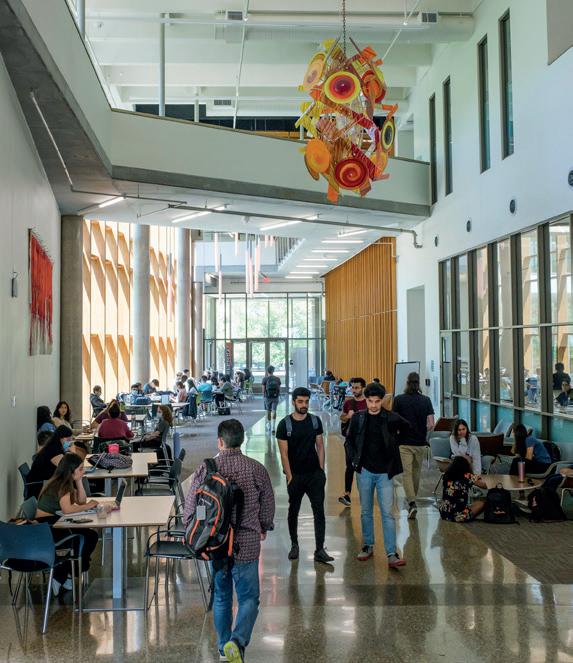
The Jindal School of Management is the largest of UT Dallas’ eight schools, with over 10,000 students coming from diverse parts of the world. Moreover, the University has an International Admissions Office and an International Students Services Office, which serve its international students, providing immigration and transitional services, cultural festivals, and English support.
“We are firmly committed to providing a welcoming atmosphere in which our international and domestic students can learn from one another

to attain the education they need to successfully navigate this complex, global society in which we live,” states Dr. Pirkul.
From a seasoned academic researcher’s point of view, Dr. Pirkul shares that outside research funding, especially for Engineering and Sciences, is an essential part of the research as research in these fields requires expensive equipment and labs as well as fellowships for Ph.D. students working in these labs. However, very little outside funding is available for business research. The primary metrics, therefore, become the publication of research in the leading academic journals to highlight academic productivity and research impact.

The Jindal School of Management comprises exemplary teachers and researchers who lead efforts toward creating an ideal learning environment for the student. community
Dr. Pirkul helped create the UT Dallas Top 100 Business School Research Rankings™, a widely used measure that he believes is his best contribution to research. The index serves as a benchmark of faculty research output in leading peer-reviewed journals and currently ranks the Jindal School fifth in North America and globally.


As the Dean of the Jindal School of Management, Dr. Pirkul considers attracting and retaining outstanding faculty and staff members as the major challenge. However, Dr. Pirkul and his team have worked hard to build a supportive environment, yet demanding excellence simultaneously.
He further explains, “Most of our faculty and staff are very happy at the Jindal School, and we have a low turnover. This is also reflected in how we support our students who are happy to be a part of our community.”
When Dr. Pirkul started as Dean in 1996, the Jindal School of Management had no specially dedicated facilities. In 2003, Dr. Pirkul helped direct the building of a 225,000 sq. ft. facility, followed by a second facility which is 115,000 sq. ft. ten years later. Presently, these buildings are completely occupied as the Jindal School of Management is now the largest school at UT Dallas, with nearly 1/3 of its enrolment.
In addition, under Dr. Pirkul’s leadership, student enrolment has grown by more than 477% — from about 2,200 to nearly 10,500 in fall 2022. Likewise, many programs now rank in the top 10 among public schools in North America, while some are in the top 10 overall, including among private schools.
The Jindal School of Management comprises exemplary teachers and researchers who lead efforts toward creating an ideal learning environment for the student community. Moreover, they are fulfilled by knowing that they are contributing to developing a special school that is prospering and serving as a role model for others around the U.S.
Dr. Pirkul’s day begins with reading the latest news and responding to emails, followed by having breakfast and commuting to school. His
According to Dr. Pirkul, flexibility and the ability to quickly adjust to ever-shifting market needs have been the keys to the Jindal School of Management’s success
time is then spent in back-to-back meetings and getting other work done in between them.
When it comes to staying calm under pressure, Dr. Pirkul has learned to be patient and not make important decisions without sleeping on them. His idea of unwinding from work is reading on a broad set of subjects, including history, anthropology, scientific developments, world economies, etc.
Dr. Pirkul feels that educators must possess intellectual curiosity and continue to hone that trait throughout their careers. “Since we encourage our students to remain lifelong learners, we must also model that example by doing what we ask of them,” states Dr. Pirkul.
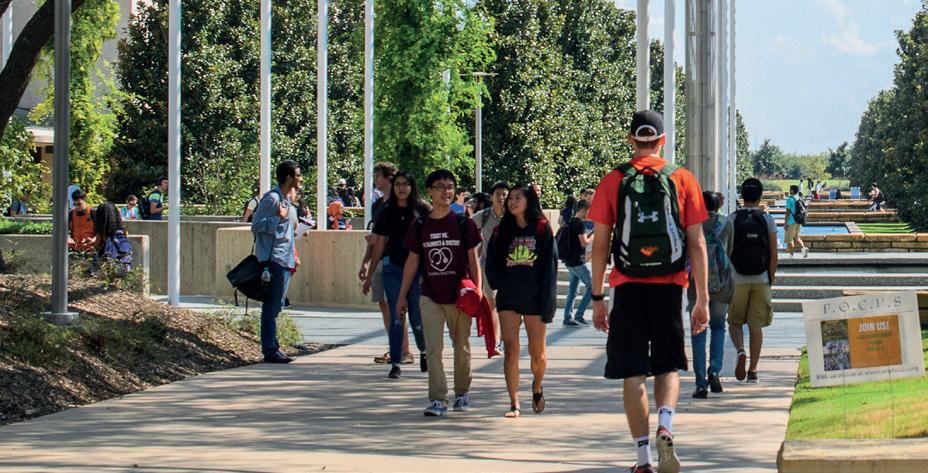
Dr. Pirkul opines that the faculty in top-tier research universities are too often stuck in that “ivory tower” mentality that offers little-to-no usefulness to industry. But there is room for the kind of research that furthers the academic knowledge base that is relevant today. Therefore, a mindset change is required in faculty members toward research, along with the need to stay in sync with the current industry trends.
According to Dr. Pirkul, flexibility and the ability to quickly adjust to ever-shifting market needs have been the keys to the Jindal School of Management’s success. He further says, “The better we can accommodate our students, the more willing they will be to seek degrees from the Jindal School.”
To cite a few success stories of the Jindal School of Management in doing this; the rapid deployment of new online programs shortly after the onset of the COVID-19 pandemic and the new Doctoral Program in Business Administration, which complements its existing highly quantitative Ph.D. programs, but is geared towards business executives launched this fall.
Currently, being in the recruiting season, Dr. Pirkul is busy interviewing potential faculty members and overseeing initiatives to improve the Jindal School of Management’s students’ life and experience. Going forward, he plans to continue hiring faculty members who can help the Jindal School of Management reach its productivity goals.

Today’s learners and faculty have high expectations, requiring an integrated and exible learning experience that operates seamlessly and intuitively. By partnering with Blackboard, you can enhance your institution’s brand by providing students and faculty with a holistic and integrated modern learning ecosystem.
Blackboard brings together the technologies and services you need to lead your institution through this digital transformation.
To learn more, visit blackboard.com
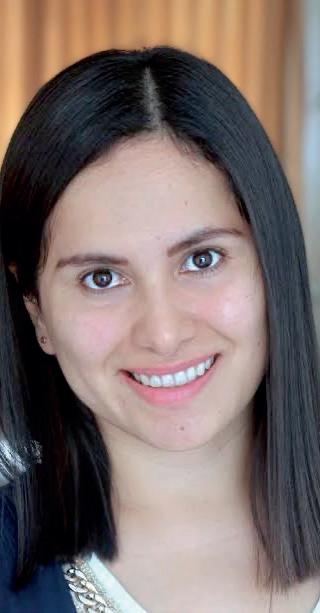
Tatiana is a certified professional in Virtual Education and E-learning. With more than 11 years of professional experience in the field of education, startups, and digital marketing, she has developed a project for the integration of blockchain technology in education, in which she sees great potential for the future. She explains that “this technology can revolutionize the way we live and can contribute to the diffusion of new educational paradigms.”
She is also a graduate of the University of San Martín de Porres in Lima, Perú.
Artificial intelligence (AI) is rapidly becoming an integral part of many aspects of our lives, and education is no exception.
As AI technology continues to advance, it is empowering students and teachers in a variety of ways, from improving the learning experience to making it easier for educators to do their jobs.
One of the key ways that AI is empowering students is by providing them with personalized learning experiences. Traditional education often follows a one-size-fits-all approach, where students are expected to learn the same material at the same pace as their peers. However, this can be frustrating for many students, as they may not be able to keep
up with the pace of the class or may find the material too easy or too challenging.
AI-powered learning platforms, on the other hand, can adapt to each student’s individual needs and learning style. These platforms use data analysis and machine learning algorithms to assess a student’s strengths, weaknesses, and learning preferences and then provide them with personalized content and feedback to help them progress at their own pace. This not only makes the learning experience more enjoyable for students but also helps them to retain more information and develop a deeper understanding of the material.
Another way that AI is empowering students is by providing them with access to a wider range of educational resources. In
With the advent of the internet and AI, students can now access a vast array of educational resources from anywhere in the world
the past, students were often limited to the materials that were available in their schools or libraries. However, with the advent of the internet and AI, students can now access a vast array of educational resources from anywhere in the world.

AI-powered search engines, such as Google, can help students quickly and easily find relevant and high-quality educational content on a wide range of topics. For example, a student who is studying ancient history can use a search engine to find articles, videos, and images about the topic, as well as primary sources such as historical documents and artifacts. This not only provides students with access to a greater variety of materials but also allows them to learn from a wider range of perspectives and sources.
Another way that a student can use artificial intelligence (AI) for learning is by using an AIpowered learning platform. These platforms use data analysis and machine learning algorithms to assess a student’s strengths, weaknesses, and learning preferences and then provide them with personalized content and feedback to help them progress at their own pace.
For example, a student who is studying history may use an AI-powered learning platform to learn about different historical events and figures. The platform may start by asking the student a series of questions to assess their current knowledge and understanding of the topic. Based on the student’s answers, the platform may then provide them with personalized content and activities to help them learn more about the topic.
For instance, the platform may provide the student with articles and videos about specific historical events or figures, as well as interactive quizzes and games to help them test their knowledge and reinforce their learning. As the student progresses through the material, the platform may continue to assess their performance and provide them with feedback and recommendations for further learning.
In addition to providing personalized content, the AI-powered learning platform may also connect the student with other students
and teachers who are studying the same topic. This can provide the student with additional opportunities to learn from their peers and experts in the field, as well as to share their own knowledge and experiences.
Overall, using an AI-powered learning platform can be a valuable way for a student to learn about a specific topic in a personalized and engaging way. By providing personalized content, feedback, and connections to other learners and experts, an AI-powered platform can help a student to develop a deeper understanding of the material and to retain more information.
In addition to empowering students, AI is also helping teachers to do their jobs more effectively. One of the key challenges faced by teachers is the ability to provide personalized feedback to each of their students. With large class sizes and limited time, it can be difficult for teachers to give each student the individual attention that they need to improve their skills and knowledge.
AI-powered tools, such as grading software and feedback systems, can help teachers to provide personalized feedback to their students more quickly and efficiently. For example, a teacher can use a grading program to automatically assess students’ work and provide them with feedback on their performance. This not only saves teachers time and effort but also allows them to provide more detailed and accurate feedback to their students.
Another way that AI is helping teachers is by providing them with access to a wider range of educational resources and tools.
For example, AI-powered platforms such as Khan Academy and Coursera offer a wide variety of online courses and resources that teachers can use to enhance their teaching and provide their students with additional learning opportunities. These platforms not only provide teachers with access to a wealth of educational materials but also offer them the chance to connect with other teachers and experts in their field.
AI-powered search engines, such as Google, can help students quickly and easily find relevant and high-quality educational content on a wide range of topics
Overall, AI is empowering students and teachers in a variety of ways. By providing personalized learning experiences, access to a wider range of educational resources, and tools to help teachers do their jobs more effectively, AI is helping to enhance the quality of education and improve the learning experience for students around the world. As AI technology continues to advance, we can expect to see even more innovative and effective ways in which it will be used to empower students and teachers.
Pradeep K. Khosla, Ph.D., is an award-winning and internationally recognized higher education leader, strategist, researcher, consultant, and a member on the technology advisory boards of many start-ups. With a career spanning over 36 years, Chancellor Khosla has donned multiple hats and excelled in all of them. His business acumen, strategic foresight for innovation and growth, and multi-disciplinary talents contribute to his uniqueness. Khosla is truly the epitome of hard work with a passion for making a difference in society.
Khosla received his B.Tech. Degree (honors) from the Indian Institute of Technology, Kharagpur, India, and M.S. and Ph.D. degrees from Carnegie Mellon University, Pittsburgh, PA, in 1984
In May 2012, Pradeep K. Khosla was confirmed as the eighth Chancellor of the University of California San Diego (UC San Diego) and began his tenure in August 2012. As Chancellor, he serves as the CEO of the campus of 42,000 undergraduate and graduate students and 34,000 faculty and staff members
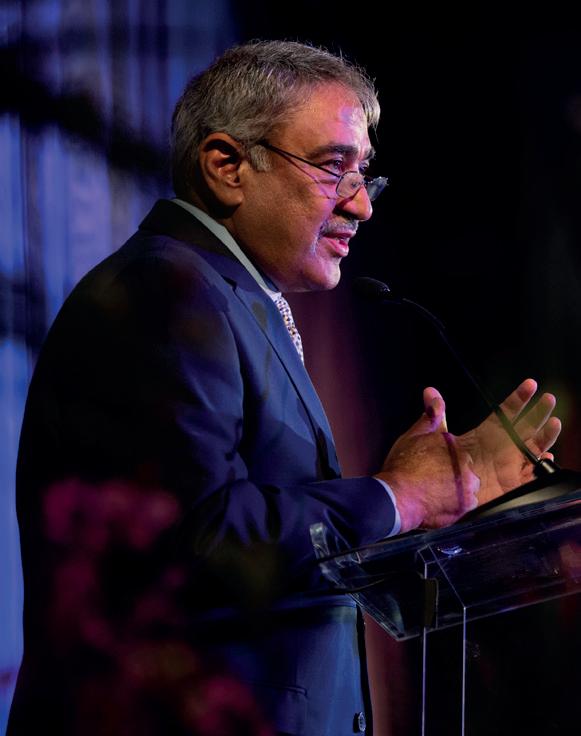
and 1986, respectively. He began his career in 1986 as Assistant Professor of Electrical and Computer Engineering and Robotics and rose through the ranks to the position of Philip and Marsha Dowd University Professor. In 1994, he joined DARPA as a Program Manager in the Software and Intelligent Systems Technology Office (SISTO), Defense Sciences Office (DSO), and Tactical Technology Office (TTO).
Later, Khosla served in several administrative and leadership roles, including the founding director of two world-class institutes—Institute for Complex Engineered Systems (ICES) and CyLab. He then served as the department head of Electrical and Computer Engineering, Director of the Information Networking Institute, and Dean of the College of Engineering at Carnegie Mellon University. During his tenure as department head, the Computer Engineering program ranked #1, and as Dean, he led the college of engineering, which improved its national rankings from #11 (in 2004) to #4 (in 2012).
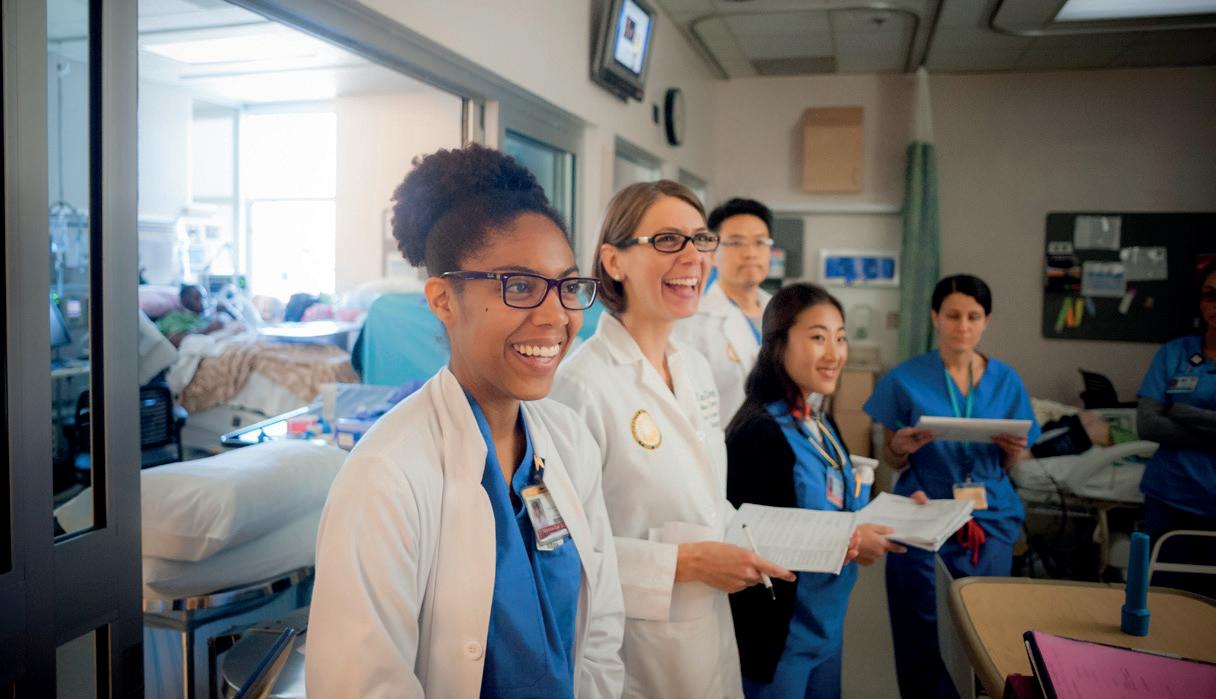
Now ranked sixth in the U.S. for research expenditures, UC San Diego’s research growth alone is more than the total research at 65 percent of the R1 universities across the country
Khosla has received several distinguished and coveted awards over the years. He received the Inlaks Fellowship, UK, the Carnegie Institute of Technology Ladd award for excellence in research in 1989, ASEE 1999 George Westinghouse Award for Education and Silicon India Leadership Award for Excellence in Academics and Technology in 2000. The following year, Khosla was honored with the W. Wallace McDowell Award from the IEEE Computer Society in 2001 for his significant contributions to the design of reconfigurable real-time software systems and to undergraduate and graduate education in electrical and computer engineering and robotics.
In 2007, he won the Cyber Education Award from the Business Software Alliance.
Khosla received the Light of India Award in the Excellence in Technology category in 2012, and in 2022 he was named to Apolitical’s 100 Most Influential Academics in Government. He has also been elected as a Fellow of the American Association of Artificial Intelligence (AAAI) in 2003, a Fellow of the American Association for Advancement of Science (AAAS) in 2004, and a member of the National Academy of Engineering (NAE) in 2006. Moreover, Khosla’s research has resulted in two books, more than 200 articles in high-impact factor journals, and numerous conference papers and book contributions.
In May 2012, Khosla was confirmed as the eighth Chancellor of the University of California San Diego (UC San Diego) and
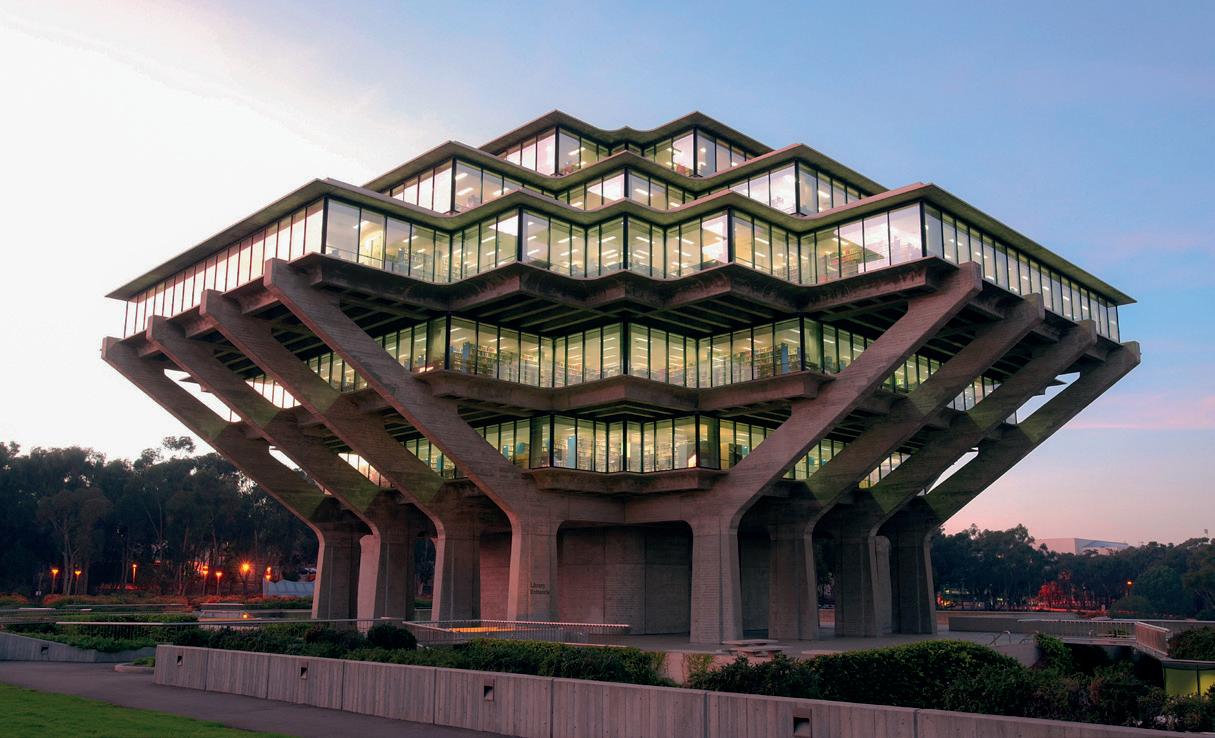
began his tenure in August 2012. As Chancellor, he serves as the CEO of the campus of 42,000 undergraduate and graduate students and 34,000 faculty and staff members. UC San Diego is also home to the prestigious Scripps Institution of Oceanography and UC San Diego Health, comprised of two hospitals and several clinical facilities that serve the greater San Diego region. Soon after he arrived, Chancellor Khosla positioned UC San Diego to redefine the future of the public research university by activating the institution’s first-ever Strategic Plan to transform the university physically, culturally, and intellectually.
“When I arrived, I could see we needed to create a space for people to talk about their aspirations for the university,” said Khosla. “At the end of those 18 months of discussion, I knew there would have to be growth to support our ambition and vision of UC San Diego.”
In 2014, his vision was summarized in eight words—the university would align efforts to be a “student-centered, research-focused, serviceoriented public university.” An ambitious 10year, multi-billion-dollar Campaign for UC San Diego was already underway to help bring the vision to life.


UC San Diego’s research strengths were evaluated and areas of growth and emerging specialties that fit well with existing strengths were identified. From this, four grand interdisciplinary research themes were set and an environment for collaborative, interdisciplinary research was championed with the goal to increase innovation and global impact. Sponsored research at UC San Diego grew from USD 943 million in 2012 to USD 1.62 billion in 2022. Now ranked sixth in the U.S. for research expenditures, the university’s research growth alone is more than the total research at 65 percent of the R1 universities across the country.
The COVID-19 pandemic provided an opportunity to expand research impact. Chancellor Khosla worked with UC San Diego’s physicianscientists, epidemiologist, public health experts, disease modelers, and researchers from across the campus to create Return to Learn, a comprehensive

UC San Diego is set to launch the Triton Center in 2025, designed to provide expanded student support services at the heart of the campus
ACE award-winning strategy to monitor, forecast and mitigate the presence of the SARSCoV-2 virus on campus and eventually more broadly throughout the greater metropolitan area. UC San Diego researchers were the first to use large-scale wastewater testing and sequencing to successfully track regional infection dynamics. Central to their efforts was SEARCH (San Diego Epidemiology and Research for COVID Health), which brought together scientists from UC San Diego, Scripps Research and Rady Children’s Hospital-San Diego to develop methods for viral tracking, including improved concentration of viral RNA in wastewater and an algorithm called “Freyja.” With Freyja, one wastewater sample can basically profile an entire city, providing an efficient, timely and cost-effective way to accurately monitor the viral load of both large and small areas of population. Freyja is free and already widely used by public health agencies across the globe for wastewater surveillance. Increased access, and a forward-looking focus on the intrinsic value of diversity, equity and inclusion also became important parts of
the university’s Strategic Plan. For example, Chancellor Khosla significantly expanded college access and affordability for students by initiating the Chancellor’s Associates Scholars Program (CASP) in 2013. In addition to providing full tuition, fees and housing for high-achieving students from underrepresented communities, the program supports students with a wide range of services and opportunities to ensure that they thrive on campus and are fully engaged in academics, student life and university experiences. To date, CASP has served more than 2,000 students from underrepresented groups and has 1,191 currently registered CASP Scholars.
UC San Diego will open Franklin Antonio Hall, named after the late UC San Diego alumnus and co-founder of Qualcomm. This major new engineering building is designed to facilitate multi-disciplinary interactions between Jacobs School of Engineering and the entire campus community, with research spaces organized

into ‘collaboratories’ that house multiple teams. It will allow students to interact with complementary teams, professors from across campus, and collaborators from industry. It joins the recently opened Design and Innovation Building, where disruptive ideas come together to spark learning, technology, collaboration and new ventures.
The Epstein Family Amphitheater, a new state-of-the-art performance venue, will also open on campus this fall. The 2,850-seat open-air venue is steps from the Central Campus station of the city’s light rail line and will showcase everything from large-scale rock concerts to classical quartets and theatrical dance.
On the health side, after opening the new Jacobs Medical Center on its La Jolla campus in 2014, the university has shifted its focus to its Hillcrest health campus, about 12 miles from its main campus near San Diego’s city center.
The first phase of redevelopment includes a 250,000-square-foot outpatient pavilion anticipated to open in 2025, which will house specialty clinical programs. The redevelopment also includes a major new hospital, a wellness center and 1,000 units of workforce housing, with nearly 40 existing buildings replaced over approximately 15 years at a cost between USD 2.5 and 3 billion.
UC San Diego is also set to launch the Triton Center in 2025, designed to provide expanded student support services at the heart of the campus. This project will include instructional support, student health and wellness services, and other student academic services and resources, along with an alumni and welcome center, a 500-person event space,
and a flexible use gallery for various campus programs, public realm improvements, and accessible parking.
“All of this is aimed at my view of what a public institution should be and the role of a public institution in a community,” Khosla said. “We want to make sure the community knows we are there for them and are expanding opportunities for the greater San Diego community like never before.”
At the close of its Campaign for UC San Diego, the university has raised USD 3.04 billion in 10 years, surpassing its original goal by more than USD 1 billion. UC San Diego is the youngest university in the country to reach a multibillion-dollar campaign goal. The transformation of the campus has been staggering with construction of five new livinglearning neighborhoods (10,000+ beds); 12 research, academic and community buildings (including a new hospital); and more than USD 50 million in campus infrastructure projects. Owing to the efforts and vision of Chancellor Khosla, UC San Diego has now emerged as a global research and academic medical powerhouse. Undergraduate applications have doubled, becoming the second-most appliedto institution for undergraduates in the country. The undergraduate student population grew by 41% and the graduate student population grew by 41 percent. And today, UC San Diego enjoys top-10 national and top-20 global rankings in a wide array of disciplines across campus.
Terrell L. Strayhorn, Ph.D., Professor of Higher Education; Women’s, Gender & Sexuality Studies at Illinois State University
Dr. Terrell Strayhorn is a Professor of Higher Education and Women’s, Gender & Sexuality Studies at Illinois State University. Author of 12 books and over 200 peer-reviewed journal articles, books, and reports, Strayhorn is one of the nation’s most prolific scholars with a leading voice on racial equity, human success, and a sense of belonging in education and employment. He is the Director of the Center for the Study of Historically Black Colleges and Universities (HBCUs) at Virginia Union University (VUU), Visiting Scholar in VUU’s School of Education, and a Lecturer in psychology. Member of the Children’s Defense Fund’s (CDF) Freedom Schools Research Advisory Committee and Diversity Scholar-in-Residence at Harrisburg Area College, Professor Strayhorn serves on several non-profit boards including Minds Beyond Measure.

“Zoom
It may be hard to believe, but it has been almost 3 years since virtually all the 4,300 colleges and universities in the United States (U.S.) were forced to pivot operations online, amid existential threats posed by COVID-19, the disease caused by a novel betacoronavirus (SARS-CoV-2). In early 2020, the World Health Organization (WHO) declared COVID-19 a global pandemic, and rightfully so—at the time of this writing, there are more than 653.8 million confirmed cases globally and, within the U.S. alone, almost 100 million cases and over 1 million deaths, according to the Coronavirus Research Center at Johns Hopkins University.
The impact of COVID-19 on higher education has been felt in other ways such as record-breaking rates of unemployment, work-related stress (e.g., “Zoom fatigue”), mental health issues, and declining student enrollments, especially at open- and broadaccess institutions. Even when they do enroll, upwards of 32-40% of U.S. college students at 4-year public and private institutions stall or stop the pursuit of their academic plans before degree completion, referred to as stoppingand dropping out in the research literature.
To that point, the National Student Clearinghouse’s Research Center recently reported the national 6-year college completion
The impact of COVID-19 on higher education has been felt in other ways such as record-breaking rates of unemployment, work-related stress (e.g.,
fatigue”), mental health issues, and declining student enrollments, especially at open- and broad-access institutions
rate is just 62.3%, virtually unchanged from prior years. Controlling for modest 1-point gains, state completion rates have flat-lined at the same time that the gender gap continues to grow steadily. Perhaps surprisingly, these trends persist despite significant policy changes (e.g., free tuition, Pell grants) and sizable investments in promising practices such as intrusive advising, accelerated pathways, emergency grants, male initiatives, and psychosocial interventions, to name a few.
While theoretically supported, much more information is needed about popular practices from in-depth qualitative projects,
causal studies, and trials in terms of “what really works” for moving the needle on college completion. Rooted in recognition of this urgent need, the American Institutes for Research (AIR) College Completion Network (CCN) invited leading education researchers, practitioners, and policymakers from across the country to the National Press Club in Washington, DC on December 13th and 14th for the Moving the Needle on College Completion Convening.
The two-day conference—which, by definition, is a purposeful gathering of likeminded individuals for focused dialogue that
While theoretically supported, much more information is needed about popular practices from in-depth qualitative projects, causal studies, and trials in terms of “what really works” for moving the needle on college completion
leads to consensus and change—consisted of concurrent breakout sessions, moderated interactive panels, funder remarks, and an engaging keynote address by Dr. Tia Brown McNair, Vice President of Diversity, Equity, and Student Success at the American Association of Colleges and Universities (AAC&U) titled, “Building Our Knowledge Base for Student Success: Realities, Opportunities, and Capacity.” Lead author of two books—From Equity Talk to Equity Walk (2020) and Becoming a Student-Ready College (2020)—McNair challenged the packed room of attendees to “be honest… [and] keep it real” as they consider the role that race, class, gender, and other protected identities play in shaping the effectiveness of certain policies, programs, and practices. She concluded that “equity-minded approaches to our work are necessary” to document what works in supporting pandemic recovery and college completion, especially for our most vulnerable populations.
Dr. Eric Bettinger, Director of the Center for Educational Policy Analysis at Stanford University and principal investigator for CCN, which is supported by funds from the Institute for Education Sciences (IES) at the U.S. Department of Education (DoE), kicked off the first day with a “framing conversation,” focused on the network’s growth over time. Two IES representatives were present— IES Director Dr. Mark Schneider and IES Program Officer Dr. James Benson—each delivering remarks affirming the timeliness of the gathering. Given the importance of highquality federal data, like that provided through
DoE’s National Center for Education Statistics (NCES), Schneider urged participants to “reach out, email, contact [us]…we need your input.”
Other sessions explored a wide range of topics, ranging from intrusive advising, student navigation, financial aid, and mindsets to developmental education, targeted interventions, and future work. For instance, one concurrent session titled “Mindsets and Psychosocial Interventions” was moderated by Rashida Welbeck, Senior Associate at MDRC (formerly, Manpower Demonstration Research Corp). Drawing on research showing that mindset and other factors, like sense of belonging, positively affect college completion, Welbeck and Dr. Greg Walton, Professor of Psychology at Stanford, called attention to applying the best evidence available to campus plans for scaling single interventions to serve larger groups of students.
After a boxed lunch, concurrent breakout sessions resumed. Dr. Denise Bartell, Associate Provost at Kent State University, moderated one session titled, “Targeted Interventions to Promote Equity,” with three panelists (in alpha order): Drs. Kayla Elliott, Director of Higher Education Policy at The Education Trust; James Minor, Chancellor at Southern Illinois University, Edwardsville; and Lashawn Richburg-Hayes, Vice President at Westat Insight. Among other things, panelists like Minor urged participants “to pay close attention” to issues of design, the fidelity of implementation, “but most importantly, to students and their voices…that’s what really matters.”
Born in the Bahamas, Dr. Sidney A. McPhee had a humble beginning before moving to the US to equip himself with the tools he needed to become the man he is today. He came to America to get a good education and learned to grow in everything he did. He received the highest honors in his Bachelor’s degree and graduated from Prairie View A&M University in Texas, a master’s degree from the University of Miami, and a doctorate in applied behavioral studies in education from Oklahoma State University. He was selected to be the President of Middle Tennessee State University (MTSU) in 2001, where he showcases his exceptional leadership and skills to better the learning environment of students at the university. Today, after 20+ years of service as the tenth President, McPhee has truly made his mark in educational circles in the US and worldwide.
I walk the campus, visit with students, eat in our dining halls, and attend events here. I get energy from seeing first-hand the diverse and enriching experiences we provide at MTSU
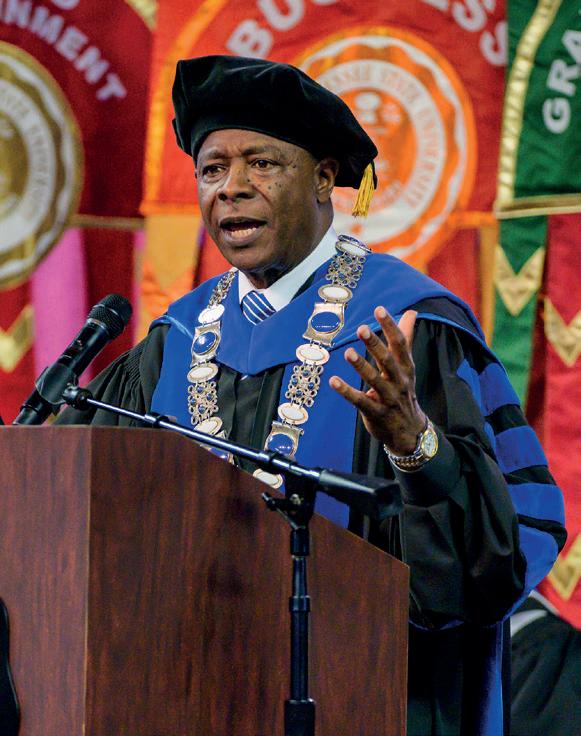
Throughout his tenure at MTSU, McPhee traveled worldwide to establish international educational partnerships. He had opportunities to lecture and make presentations and friends in China, Japan, South Korea, Israel, Belgium, Canada, England, Brazil, Ethiopia, Kenya, and of course, back home in the Bahamas. “This experience has provided me with valuable opportunities to learn from various cultures and perspectives and how to adapt to various environments and situations,” he shares.

McPhee’s early education was in public schools in the Bahamas. The country’s geography
includes over seven hundred islands and cays in addition to the capital Nassau, where he grew up. In total, the Bahamian islands extend over seven hundred miles. Yet, the community is a cohesive nation, referring to the outlying areas as “family islands.” Bahamians, in general, are friendly and outgoing. “Growing up in a large family and a country that in many ways sees itself as a big extended family has influenced my tendencies to reach out, connect with others, and create synergies. This perspective helped me lead the university through difficult situations like the pandemic by encouraging our students, faculty,
and staff to not isolate themselves, but rather to view this time as rejuvenation,” McPhee says. “My educational journey also set me on a path of reaching across the globe to form international partnerships and recruit international students and faculty. I think it’s vital to know where you come from and how that connects with the world,” he adds.
As the President, McPhee has brought fame and fortune to MTSU. For four consecutive years, the Princeton Review identified MTSU among the best 13% of colleges in the United States. US News & World Report named the university a “Top Performer in Social Mobility,” while Newsweek recognized them as a Best Maker School for its innovative MakerSpace lab. The aerospace programs earned GradReports No.13 rank of their 25 Best Aviation Schools. SuccessfulStudent.org ranked the program’s unmanned aircraft system program No. 17 in the nation. College Choice recognized the College of Education among their top five Most Affordable Online Masters in English Language Learning. For the seventh consecutive year, Billboard magazine named MTSU’s College of Media and Entertainment’s Recording Industry Management program a Best Music Business School in the U.S. These are just a few of the many rankings and recognitions that have contributed toward MTSU earning the reputation as Tennessee’s No.1ranked public university for return on investment. “It’s also significant to recognize our substantial investments in our facilities and infrastructure at MTSU. I’ve been honored to preside over USD 1.5 billion in improvements, new construction, and major renovations during my presidency,” shares McPhee.
Leaders need to keep their ears to the ground in an ever-changing world. McPhee does this by
As the President, McPhee has brought fame and fortune to MTSU. For four consecutive years, the Princeton Review identified MTSU among the best 13% of colleges in the United States
Our vision focuses on MTSU faculty, staff, and students working together as a community of scholars to create and share knowledge. We envision our efforts resulting in the highest quality education and student experience, preparing citizens who thrive as professionals and engage with and contribute to their communities
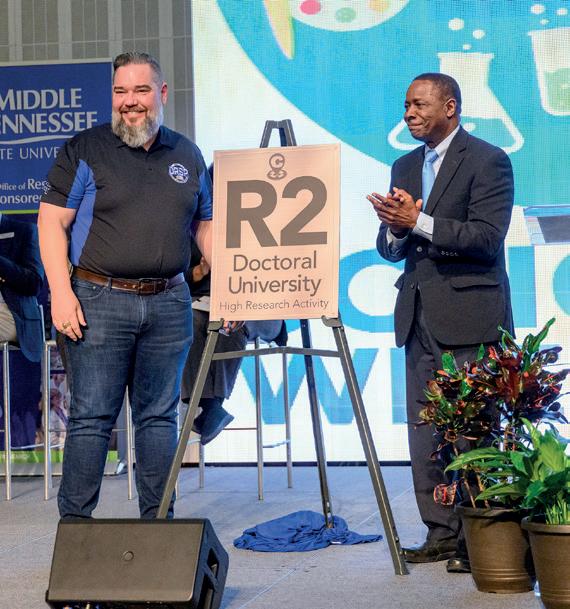
dedicating time to catching up with the latest developments in the higher education space, inculcating those practices in the best way possible into the environment of MTSU. “I also walk the campus, visit with students, eat in our dining halls, and attend events here. I get energy from seeing first-hand the diverse and enriching experiences we provide at MTSU,” says McPhee. He also takes it upon himself to engage himself in the pulse of the diverse campus community. Being close to Nashville, the ‘Music City’ of the US, MTSU is fortunate to be surrounded by a vibrant music scene.
In the aftermath of the COVID-19 pandemic, MTSU, like all national and international higher education institutions, has been preparing for a “demographic cliff” with smaller numbers of 17- and 18-year-olds who would be traditional first-time, first-year students. At MTSU, the management is responding to these trends by offering dual enrollment and dual credit opportunities to high school students, providing them an accelerated path to earning their bachelor’s degrees. In the fall 2022 semester, MTSU enrolled over a thousand dual-enrollment students. This fast-track approach has a domino effect of positioning students to matriculate into advanced degree programs at an accelerated rate and earning post-baccalaureate degrees earlier in their academic careers.
The region was fortunate to have robust economic growth, which meant that graduates were in demand, thus creating better placements and demand for knowledgeable, highly skilled employees. The challenge lies in the decline in the number of citizens seeking postsecondary education of any kind due to the disruptive impact of the pandemic. Of course, this has the potential to negatively affect workforce development and
lifetime earnings. In response to these economic growth opportunities and resulting employment demands, MTSU has created educational and professional development opportunities for the region’s workforce through which the university works with employers to understand their unique needs. Based on this input,customtailored academic programs are created to fulfill those needs. The university also allows students to translate their work experience into academic credits and has expanded its online programs to meet the needs of working adults. However, the university’s strategy doesn’t stop here. “We are actively collaborating with job creators and forecasters to predict workforce trends so we
can prepare students for future jobs, ahead of the curve, before the need becomes a crisis,” explains McPhee.
McPhee strongly believes in the importance of really understanding one another. “That belief has guided my work in every job I’ve held, and that is what I set out to do on my first day at MTSU. I wanted to know the people who comprise this university, those who carried forward their ancestors’ work of building the larger community and the newcomers who helped it thrive and grow,” he explains.
Middle Tennessee State Normal School was founded in 1911 with a two-year academic program devoted to the education of teachers. In
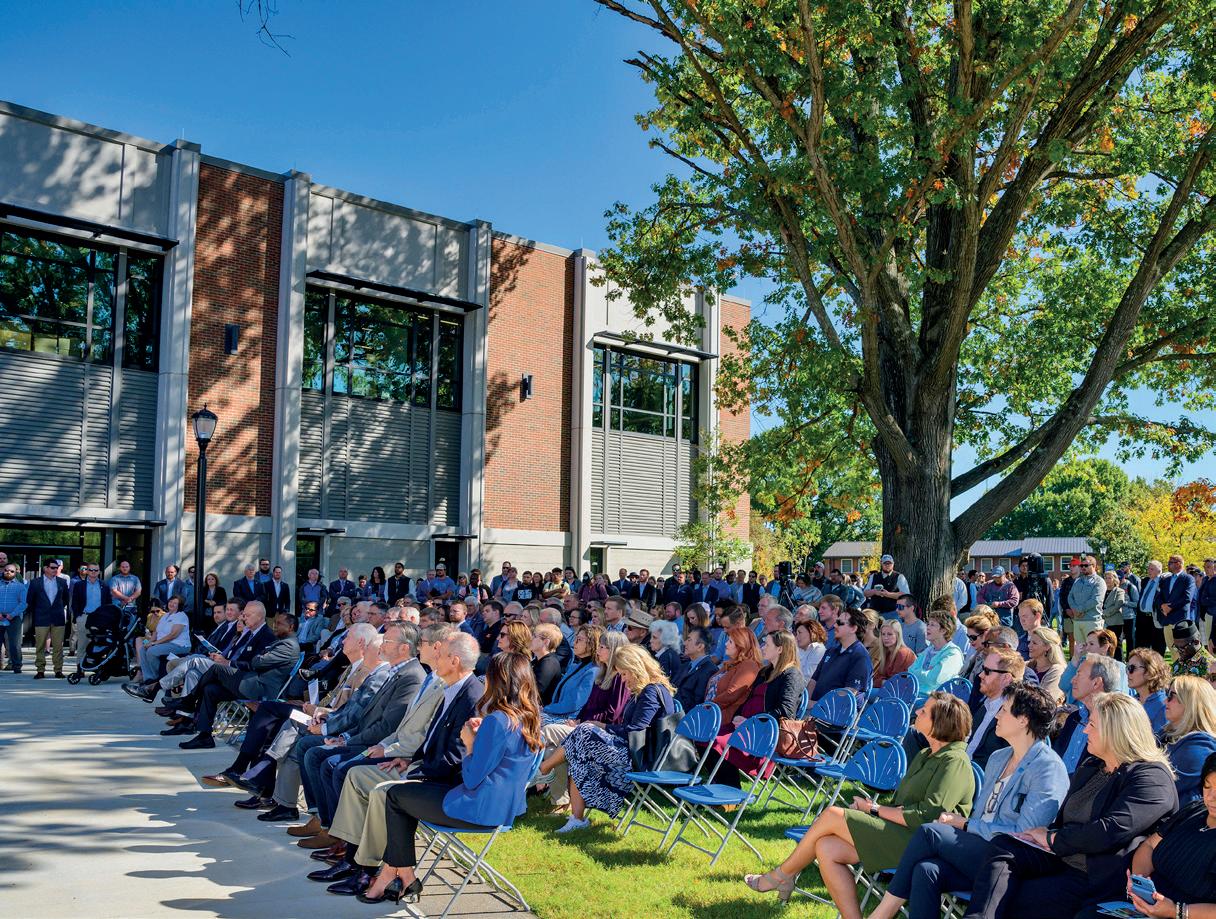
1925, the school evolved into Middle Tennessee Normal College with a four-year degree program leading to a bachelor of science degree. The Tennessee General Assembly designated the institution a state college in 1943. In 1965, the institution advanced to university status.
MTSU embraces its role as a comprehensive, innovative institution whose distinctive bachelor’s, master’s, specialist, and doctoral programs prepare graduates to thrive within their chosen professions and changing global

society. Students, faculty, and staff generate, preserve, and disseminate knowledge and collaboratively promote excellence through teaching, learning, research, creative activity, and public engagement.
“Our vision focuses on MTSU faculty, staff, and students working together as a community of scholars to create and share knowledge. We envision our efforts resulting in the highest quality education and student experience, preparing citizens who thrive as professionals
and engage with and contribute to their communities,” McPhee says.
MTSU’s USD 147-million, three-building Science Corridor of Innovation represents the largest single investment by the State of Tennessee into an academic facility. The main 250,000-square-foot Science Building houses the Biology and Chemistry departments, providing a state-of-the-art laboratory and collaborative space for learning. In 2020, the university opened a new Academic Classroom Building that brought the Criminal Justice Administration, Psychology, and Sociology departments under one roof. This facility represents a USD 39.6 million investment that connects academic programs, minds, philosophies, and perspectives. Through this unique cross-disciplinary collaboration, MTSU is building an understanding of the needs and challenges that practitioners of each discipline will face as they enter the workforce. Equipped with this understanding, students will be better prepared and poised to offer solutions as they serve society.
With the pandemic’s lingering health and economic effects layered on top of the call for social justice, MTSU offers a pipeline for frontline workers to become expertly trained in these intersecting disciplines. “We know that human interaction is key to successfully addressing these issues facing humanity, and by removing physical barriers that impede collaboration, we help remove barriers in our wider society,” explained McPhee. The proximity that this building provides promotes exciting connections and transformative solutions that harness the collective intellectual energy of the students, faculty, and staff at MTSU.
MTSU just celebrated this fall a ribboncutting ceremony to mark the opening of the

MTSU has 40 university partnerships in 17 countries and the largest enrollment of international students of any university in Tennessee
new USD 40.1 million building to house the university’s School of Concrete and Construction Management (SCCM). This program is the first of its kind in the U.S. and still stands as one of only five such programs in the nation. “Our Concrete Industry Management and Construction programs were designed in response to dire workforce development needs. A key strength of the program is that the coursework combines necessary elements of both engineering and business management to produce graduates who are knowledgeable in both areas and therefore well-suited to progress high into corporate leadership,” shares McPhee. The employment rate for these majors approaches 100% every year, and the average starting salary of the graduates this year with a bachelor’s degree was over $63,000.
The new SCCM 54,000-square-foot facility includes a 200-seat lecture hall; a quartet of basic materials and building labs; a dedicated mechanical and electrical plumbing classroom; a covered amphitheater; and two computer labs, including a virtual design and construction lab that’s capable of creating advanced building models and construction simulations, as well as an augmented virtual reality lab for immersive experiences. This building is a sophisticated
instructional tool, with educational elements deliberately and intelligently integrated into its design. Meanwhile, in 2023, McPhee said MTSU will begin construction of a new facility for its Applied Engineering program. “Both undergraduates and graduate students are provided with opportunities to work alongside and learn from our world-renowned research faculty,” McPhee says.
MTSU has 40 university partnerships in 17 countries and the largest enrollment of international students of any university in Tennessee. Comparing the numbers of international students from fall 2021 to fall 2022, applications (+34.14%) and admissions (+17.55%) have increased significantly.
MTSU’s USD 13.2 million funding raised from extramural sources, including USD 5.1 million in new research funding, was a pivotal contributing factor to the university’s recent elevation to an elite “R2” Doctoral University, High Research Activity status in the Carnegie classification of institutions of higher education.
“Securing funding sources is a challenge, particularly with economies experiencing inflation worldwide. Our model includes
MTSU just celebrated this fall a ribbon-cutting ceremony to mark the opening of the new USD 40.1 million building to house the university’s School of Concrete and Construction Management (SCCM)
cultivating relationships to raise public/private funding,” McPhee says. The privately owned company Greenway Herbal Projects gave USD 2.5 million to promote MTSU’s medicinal plant research in the university’s Tennessee Center for Botanical Medicine Research (TCMBR). While the Walter and Edith Loebenberg Foundation helped fund initial start-up costs.
Federal U.S. funding agencies also play a vital role. The United States Department of Agriculture has invested heavily in MTSU’s botanical medical research. The International Ginseng Institute at Middle Tennessee State University has received a total of USD 747,500 —including a USD 455,000 grant award from the U.S. Department of Agriculture’s National Institute of Food and Agriculture. These research
funding agencies recognize the potential value that wild-cultivated ginseng crops represent with a market price that demands 10 to 25 times more per pound than field-grown ginseng. Wildcultivated ginseng also yields significantly greater profits for farmers when compared to crops like corn.
Ahead on the horizon, MTSU is poised to open a state-of-the-art Aerospace Academy, thanks to USD 62.2 million in state funding designated to accommodate the explosive growth of the university’s Aerospace Department’s professional pilot program. The project includes constructing an 83,000-square-foot academic building and three hangar structures to serve as laboratory and support spaces in a worldclass aviation academy. MTSU’s Aerospace
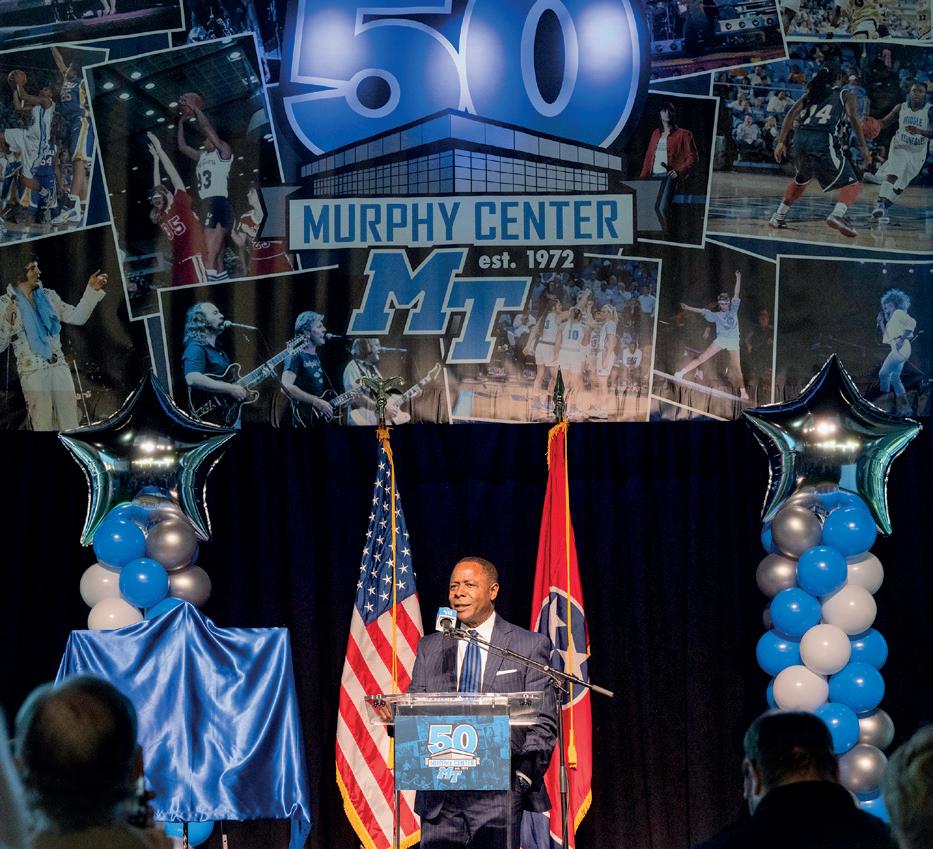
Department grew out of World War II pilot training in the 1940s. Aerospace has grown into one of the most respected programs in the country. Twenty full-time faculty members, 100plus flight instructors at the Flight Operations Center, and more than 1,200 majors place it among the largest of the nation’s collegiate aviation programs.

Four years ago, MTSU was among the first universities selected for Delta Air Lines’ Propel Collegiate Pilot Career Path program. Delta created this fast-track initiative to encourage qualified pro pilot majors to pursue a defined, accelerated path. The program allows candidates to earn their flight certifications, build their experience and meet all requirements to become a Delta pilot in 42 months or less. Colton Gray, an MTSU alumnus, made history as the first graduate of Delta’s Propel program. MTSU is in similar conversations with other American
commercial air carriers to create pilot pathway program partnerships similar to Delta.
On the international front, a college in Jiangsu province approached MTSU to help China meet its demand for aerospace. China’s central government is expected to open general aviation space to private enterprises, creating a demand for aerospace facilities. Jiangsu officials anticipate as many as 500 airports will be built in the coming years — and more than 3,000 will open within a decade. It speaks to the international reputation of MTSU’s aerospace department to be selected as one of the first partners of this new college. The demand for expertly trained pilots, air traffic controllers, mechanics, and unmanned aircraft system operators is at a historic high worldwide. MTSU continues to work with universities in countries around the world to form similar partnerships.
To remain a viable option, higher education institutions must provide pathways and build bridges that ensure affordability and access.
MTSU understands that ‘affordability’ means different things to different people. While a university education represents a substantial investment, finding the lowest overall cost that meets your specific objectives is important. MTSU is, very simply, the best higher education bargain in Tennessee. “Our combination of high-quality programs, student resources, incredible scholarship programs, and low tuition costs are unmatched in Tennessee.
MTSU has the lowest tuition rate of any major university in the state, and we’ve expanded and increased our scholarships, redesigning general education programs and courses in the major to connect learning to professional development and civic engagement,” explains McPhee.
The results confirm the success of MTSU’s commitment to these priorities. In the fall 2022 semester, the university saw increases in retention for freshmen (75.7%, up 1.6%), undergraduate (82.5%, up 0.4%), and graduate students (86.3%, up 2.4%), trends that are especially encouraging as we emerge from the pandemic.” Our four-year graduation rates have more than doubled since launching Quest for Student Success, our series of academic strategic plans that began in 2013 and were recently updated. Six-year graduation rates have increased by ten percentage points,” reveals McPhee. In recognition of these positive results, MTSU was among 19 institutions selected as part of the American Association of State Colleges and Universities Student Success
Equity Intensive funded by the Bill & Melinda Gates Foundation to close achievement gaps.
“Our plans focus on a nimble, responsive approach that includes working with employers to fulfill their needs; expanding our online programs to meet the needs of working adults through our graduate programs; and collaborating with job creators and forecasters to predict workforce trends.
We are preparing students for future jobs, ahead of the curve, before the need becomes a crisis,” shares McPhee.
Despite current challenges like inflation, population growth and economic development in Tennessee indicate a positive outlook for MTSU and Middle Tennessee’s higher education sector. The university plans to continually monitor workforce and community needs to inform degree offerings, course schedules, facilities and technologies, and public programming. “We will increase access to higher education through targeted recruitment of new and returning students of all ages and backgrounds; by expanding the types of in-person and virtual learning environments, we offer; and by keeping the cost of higher education within reach of students and their families through increased state support and external funding as well as scholarships,” says McPhee. “We continue to prioritize recruiting and retaining top-flight faculty and staff essential to moving MTSU forward. Lastly, we will ensure that our nationally recognized academic and student support services and our faculty and staff’s excellent teaching, mentoring, and advising benefit all students,” he adds.
Dr. Nikola Perovic is an international management consultant and coach, who specialized in cross-cultural relations challenges,andinternationalmarketing.Heistheauthorofthebook “TheInternationalPost-AcquisitionManagement”whichincludes16case studies on international management changes and integration in selected companies in various industries. He was a university professor of international business and marketing at the Higher Colleges of Technology in Dubai from 2015 to 2021. Previously he was a lecturer at various universities in South Eastern Europe. He held international seminars/conference speeches on cross-cultural management, marketing management,internationalacquisitions,internationaltrade,exportmanagement,andmanagement in tourism. He has been an international consultant for the International Trade Center (Geneva), the exportpromotionagencyoftheUnitedNations,andtheWorldTradeOrganization.

Post-Covid times put pressure to change leadership at all levels: teams, departments, companies, communities, government, and international organizations. These days we understand that leadership has to be inclusive, innovative and focused on change management. Even the ways how we communicate have been changed in the manner that it has to be more open, caring, and long-term driven. Can we achieve all these improvements in leadership and communication if we don’t expand our understanding of cross-cultural relations? Certainly not, as we have to utilize every human potential regardless of culture or any other diversity.
Many cross-cultural trainings are focused on what is acceptable, and what is not in a specific cultural setting. They are dominated by a focus on differences, and a better understanding of foreign cultures, and quite often they create a perception that foreign cultures are unattractive and filled only with constraints. Contemporary cultural training should be focused on adaptability and convergence, meaning that we should find ways how to connect more, not how to divide. As a final impact of the cross-cultural training, participants (students or employees) should become culturally resilient, and consequently unleash global potential regardless of cultural
should be triggered.
boundaries
Contemporary cultural training should be focused on adaptability and convergence, meaning that we should find ways how to connect more, not how to divide
Global communication skills are important for all who want to engage in any intercultural scenario, which basically is most of humanity. Cities such as London, or Dubai with more than 200 nationalities living and working together, can only thrive if we all learn how to learn from different cultures. This process can be natural quite often, but universities and the corporative sector have to know how to organize cross-cultural training to extract maximum talent potential coming from cultural diversity. We need a skilled approach to this “extraction” and the following are the steps that can improve cross-cultural learning:
1. Understand fundamentals of culturesour own, and others. Cross-cultural coding can be implemented here. A. Molinsky (Global Dexterity Method) proposes 6 codes: levels of directness, enthusiasm, formality, personal disclosure, assertiveness, and self-promotion. These codes vary among different cultures, but also among our own personal comfort zones.
2. The second step is to examine your personal acceptance of these codes and to identify the gaps. We need to find out the level of ‘stretchiness” possible to get closer to the desired level of these codes. How far can one be more or less direct, engage in self-promotion,
It is critical to have cross-cultural trainers that possess certification in cross-cultural management with extensive personal experience in international communication, business, and relations
etc? Be honest with yourself, as sustainable results are possible only if adaptability comes naturally. Find the level which is agreeable to your own personal values. Examine the ways how to deal with them by focusing on mutual goals within your teams, and by finding the common ground. Try to understand the cultural logic behind specific behavior. More often than not you might justify and better understand different approaches once you grasp this logic. Cultures are mainly protective of nature, and that is common for all of them. Once you get familiar with such an experience, you will become more respectful of various diversities, more open-minded, and will be able to focus on the positive sides of cooperation.
3. Look inside oneself to understand the psychological challenges that cultural adaptation brings to you. These can be authenticity challenges, likability, resentment, or even competence challenge when communicating in a foreign culture. It is important that you don’t underestimate these emotions, as the whole training will be only partially successful in the short term. You can manage these challenges by using different dialog, timing, body language, or customized context (Global Dexterity Method). These will increase your comfort in the process of adaptation.
4. Practice cross-cultural communication with verbal and non-verbal signs, understand the differences and appreciate diversity. Use cross-cultural role plays, games, and
simulations as tools. This can be a fun and bonding experience in team training.
5. Focus on win-win negotiation. Different values in different cultures are of higher or lower importance for members of different groups. Therefore, it is possible to have won for all in such situations. Understand core values in both cultures and create solutions that are aligned with these values. It is possible, as long as we engage in transformative negotiation which leads to impactful motivation, and long-term cooperation. Remove the simple transactional approach, and it will work. Transformational negotiation is aligned with transformational leadership, which is preoccupied with organizational improvement and sustainable development.
Truly understanding different cultures comes from living and working in different cultures. It is critical to have cross-cultural trainers that possess certification in crosscultural management with extensive personal experience in international communication, business, and relations. Ask your trainers to always provide personal examples since those will make every training as interactive as possible since most of us love personal stories. These can very often be fun and entertaining, which would even more positively influence learners’ satisfaction. Culture is always evolving, so there is no final end to crosscultural education, and that’s why this training has to be engaging and stimulating.
A.J. Merlino, Associate VP of Student Professional Development & Experiential Learning, Harrisburg University of Science and Technology
A.J. Merlino is a five-time GRAMMY-nominated music educator with a passion for cultivating creativity and innovation in higher education. His background in the arts as a performer and large-scale project manager helps inform decisions as a business strategist, bringing a unique perspective to the educational landscape. As a touring musician and clinician, he has presented in Scotland, Croatia, Greece, Thailand, Canada, Australia, and Argentina. Dr. Merlino has worked as a project manager, music director, composer, and performer for many projects held at The Venetian, Mandalay Bay, MGM Grand, and Cosmopolitan in Las Vegas. Dr. Merlino’s experience collaborating with campus leadership and community partners has successfully increased students’ educational programming and learning opportunities while positively impacting student enrollment, matriculation, retention, and outcomes through career-level engagement.
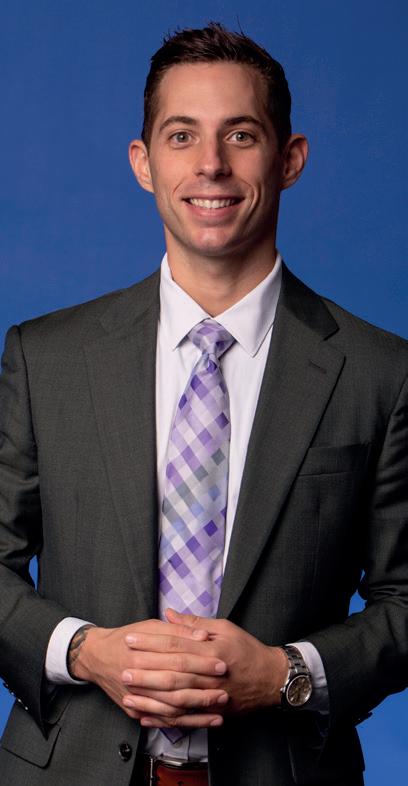
Educational institutions have long used academic learning communities to bring individuals together from various disciplines to collaborate on projects, thereby enhancing student engagement, achieving learning outcomes, and connecting project work with real-world applications. As a professor and administrator in higher education, I have created and managed numerous academic learning communities using my professional experience as a project manager. Implementing academic learning communities using this approach showed improvements in institution-wide recruitment, retention, graduation rates, and positive postgraduate outcomes. The following are foundational
best practices for forming and developing academic learning communities using project management principles.
Prior to initiating a project, it is essential to identify team roles within each academic learning community. Although this approach has many variations, including a project sponsor, a project manager, and a project team is most beneficial. A project sponsor provides necessary resources to a given project, serves as a bridge to external stakeholders, creates a list of work, prioritizes tasks, and ensures that the project meets the strategic vision of the governing institution. An administrator, a chair of a department, or an instructor may
A more effective approach to selecting student personnel is based on interest or affinity, which may be solicited in consultation with the student services office responsible for student clubs, activities, and student government
hold this role. The project manager oversees a project from conception and initiation through project close. They are responsible for supervising tasks, removing impediments, managing resources, setting timelines for practical completion, and documenting each step of the process. This role is best reserved for an instructor or student who has experienced several project iterations through an academic learning community. Project team members collaborate with project managers to map goals and are responsible for the hands-on work required for completing tasks and creating a definition of done with the concurrence of the project manager. Students in the academic learning community should hold this role. An effective project team is self-sufficient and is empowered by a project manager to seek solutions rather than ask permission to complete tasks. Ideally, each team would consist of a project sponsor, a project manager, and 3-8 project team members to optimize communication and productivity.
Before implementing an academic learning community, it is essential to work with institutional administrators such as deans, department chairs, or program leads to prepare a project charter. A project charter is a document issued by the project sponsor, giving a project manager authority to begin work. The charter may include project rationale, requirements, timeline, stakeholders, objectives, budget, and scope. When considering using this document for learning community development, this is an opportunity for a project sponsor and project manager to work together to connect
program learning outcomes with institutional core competencies through experiential learning opportunities and key assignments. Through this process, assessment metrics may be applied, and longitudinal data regarding project impact may be collected. Once the project charter is created, project teams can be determined.
Group or team development is an oftenoverlooked part of implementing academic learning communities in higher education. Using Tuckman’s Stages of Group Development, educators can cultivate effective teams and normalize positive habits within a given academic community. Implementing Tuckman’s approach begins with selecting student personnel, which is the project manager’s responsibility. Instructors and administrators who take on this initiative frequently select groups by class or program of study, creating a homogenous project team that does not have the ability to complete largescale, true-to-life projects. A more effective approach to selecting student personnel is based on interest or affinity, which may be solicited in consultation with the student services office responsible for student clubs, activities, and student government. By using this cross-disciplinary approach, a wide range of students from various programs, class years, and backgrounds may come together to complete a particular project, connecting students’ curricular, co-curricular, and social interests across multiple programs of study.
During an academic semester or year, the goal is to move through Tuckman’s stages
(forming, storming, norming, performing, adjourning) to enhance the effectiveness of a team and achieve predetermined learning objectives. Although a complete implementation guide for Tuckman’s stages is outside the scope of this article, some fundamental principles for each stage include:
Forming – The team is introduced to the project mission and develops goals, which builds preliminary trust. At this stage, tasks may not have been accomplished. A qualitative survey with questions regarding student reactions/feelings about the project and group may be used to create a baseline, which will become helpful for later reflective assignments.
Storming – The team experiences disagreements or project impediments and views themselves as individuals rather than a cohesive unit. At this stage, tasks are being accomplished, but not all project team members are actively involved. Since many of the team members will come from different backgrounds and possibly different disciplines, an open discussion forum that details ‘what I need from you’ or ‘what I believe I have to offer the group…’ is a valuable assignment for students to engage and understand each other.
Norming – The team begins to work together and collaborate on

tasks to support each other’s strengths. Trust is built in this stage, and positive behaviors are normalized. A meaningful student assignment in this stage deals with appreciation and gratitude for their team. Using a shared document for sticky notes, create an assignment that requires students to write three notes of gratitude to other students. A project manager may also create a self-assessed team evaluation tool relevant to the students’ baseline survey.
Performing – The team is predominately self-sufficient and effective at accomplishing tasks. Project managers may work with individual team members to enhance their skill sets during this stage. Since each student should perform at their highest level, this may be a proper time to assess the completion of tasks for quality and timeliness, while rewarding the project team for their achievements.
Adjourning – The team’s work is complete and moves on to a new project. This stage is an excellent opportunity for the project manager or project sponsor to use a reflective assessment
tool to enhance students’ attainment of learning objectives.
To oversee progress, the project manager must determine a single centralized source of truth, such as a virtual task board. Examples of such boards include Trello, Asana, ClickUp, and Teams’ integrated task management system. The tasks are often categorized into five buckets, in alignment with Tuckman’s model using the terms initiation, planning, execution, performance, and closure. For example, suppose the project manager is the course instructor. Tasks may be assigned on the board to students through each phase to complete course objectives while collectively moving forward through project goals. Using a flipped classroom yields the most favorable result, as this approach allows student exploration and discovery at home while reserving class time for collaborative work such as stand-up meetings, addressing impediments, reviews, and reflection.
An effective project team is self-sufficient and is empowered by a project manager to seek solutions rather than ask permission to complete tasks
